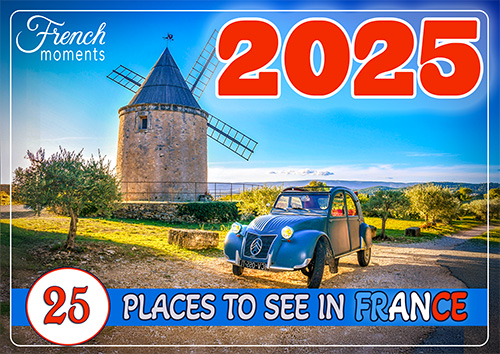In this article, I invite you to travel to Speyer, Germany crossing the border just north of Strasbourg and heading northeast.
After a 80 km (50 mi) journey, we arrive in this former imperial city, nestled along the Rhine in the state of Rhineland-Palatinate.
Speyer is renowned for its monumental Romanesque cathedral, one of the largest and most significant Romanesque churches in the Holy Roman Empire.
Today, the Speyer Cathedral is a UNESCO World Heritage Site, a testament to the city’s remarkable architectural heritage.
A visit to this historic gem in the Palatinate is highly recommended, especially if you’re staying in northern Alsace.

Speyer Cathedral and the Rhine from above
Discover Speyer, Germany
Speyer is the city of my childhood.
A historic town I know like the back of my hand, having lived there for nearly a decade.
Back then, digital cameras didn’t exist.
From my life in Speyer (and my visits in the 1990s), I have only a handful of film photographs.
This explains why, to illustrate this article, I had to source royalty-free images from elsewhere on the web.
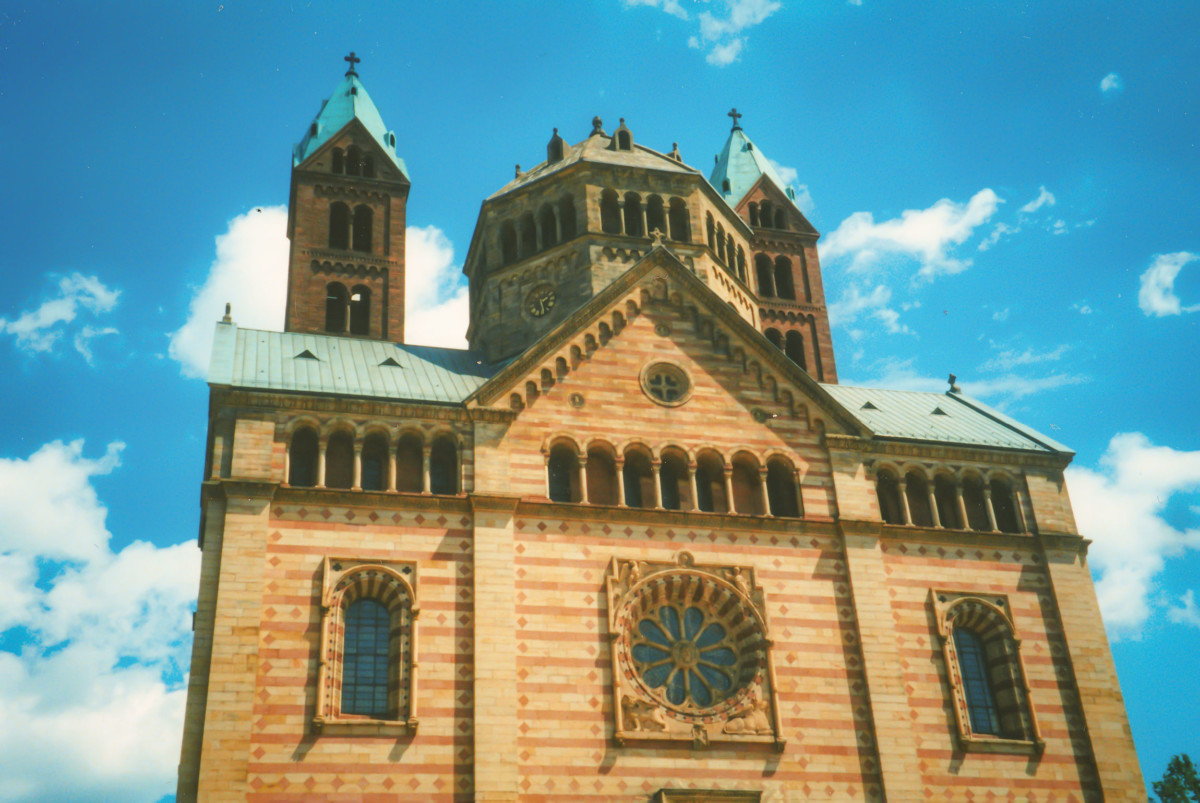
My film photograph of the western façade of Speyer Cathedral © French Moments
But that doesn’t mean this article won’t have an authentic touch, filled with lived experiences!
I wanted to create a thorough guide to my beloved German hometown for two main reasons:
- It brings me joy to reminisce about the "good old days," those fond memories of my childhood in the Palatinate.
- I couldn’t find a single French webpage offering a comprehensive tour of Speyer.
Without further ado, let’s step into the imperial city of Speyer!
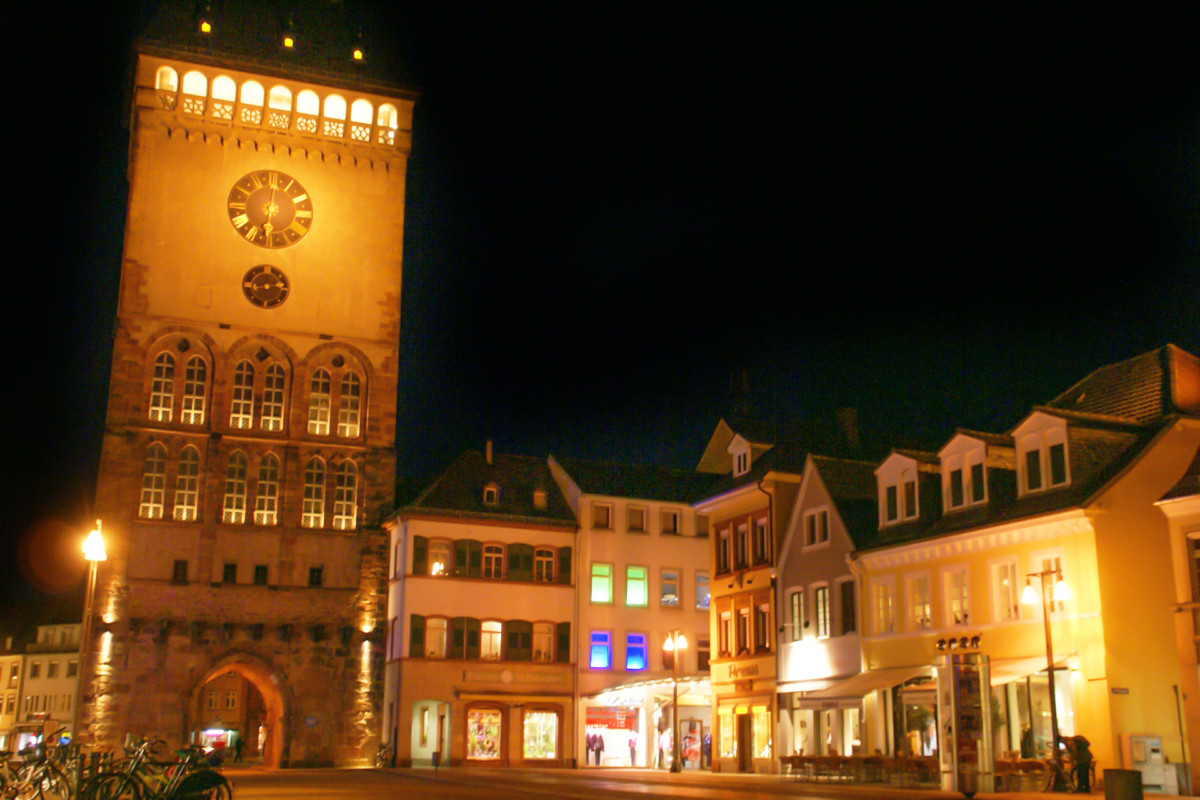
Speyer's Altpörtel by night. Photo : Hermann Luyken (Public Domain)
Speyer or Spire?
Where does the name of this historic Palatinate city come from?
It’s worth noting that Speyer is one of the oldest cities in Germany.
Its origins date back to the Romans, who established a military camp with a garrison of 200 to 300 men around 10 BC.
Before long, this military post grew into a settlement, becoming a city around 10 AD.
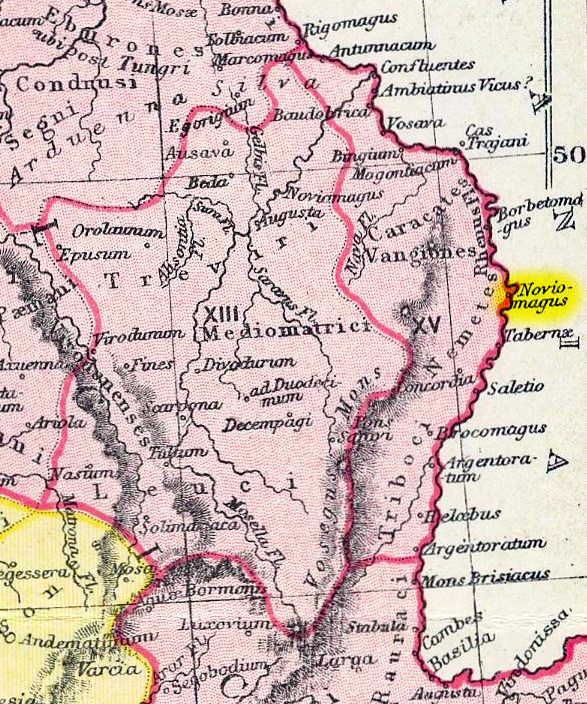
Map of a portion of Gallia Belgica, showing the territory of the Nemeter tribe. Speyer is depicted as "Noviomagus."
Around 150 AD, the settlement appeared under the Celtic name "Noviomagus".
Later, the name Spira was given to the city when it and its surrounding territory came under Alemannic control.
This new name was first recorded in 614 during the Council of Paris, which brought together around sixty bishops, including Hilderich of Spira, the bishop of Speyer.
The Council of Paris took place on 10 October 614 at the Basilica of Saint Genevieve (the site of today’s Lycée Henri-IV near the Panthéon).
From Spira, we get:
- Spire in French,
- Spires in English (though rarely used), and
- Speier in Old German (used until 1825), later evolving into Speyer.
The inhabitants of Speyer are called Speyerer in German… and Spirois in French! Charming, isn’t it?
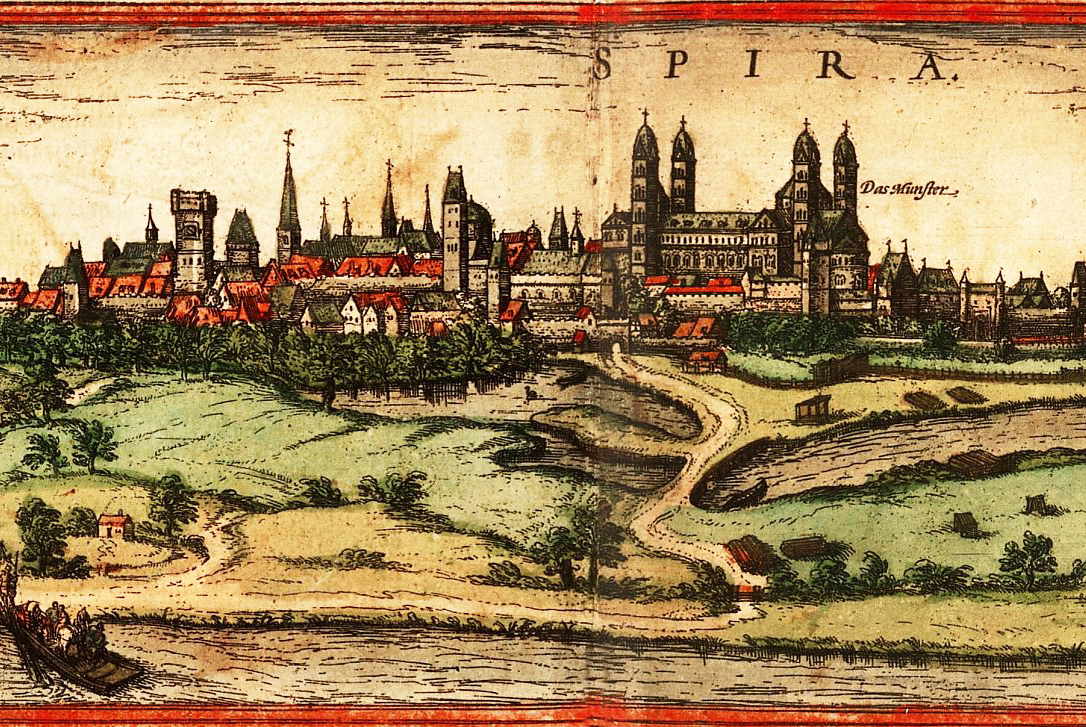
The city of Speyer in the 16th century
Staying in Speyer, Germany
During the summer months, accommodations in Speyer can fill up quickly. It’s advisable to book your room as early as possible!
Alternatively, you might opt for a holiday rental, a guesthouse, or even a campsite.
To plan your stay in Speyer, Germany, click on this link to visit booking.com or explore the map below:
The "French Connexion" of Speyer, Germany
The French border lies just 50 kilometres from the city of Speyer in Germany.
Strasbourg, the capital of Alsace, is only 115 km away by road. In other words, France is just a stone’s throw away...
The border hasn’t stopped Speyer from maintaining close ties with France—sometimes for the better and sometimes for the worse!
In fact, the history of Speyer revolves around a key year that involves the French (and, in this case, it’s definitely for the worse!).
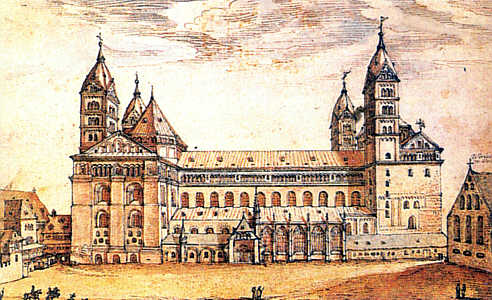
Speyer's Kaiserdom in 1610
1689: The Cursed Year of the Palatinate's Sack
To truly understand Speyer, one must remember the year 1689, when the French troops of Louis XIV invaded the Palatinate region.
The sack of the Palatinate was a military operation carried out by Louis XIV’s forces—born from a misguided idea by Louvois.
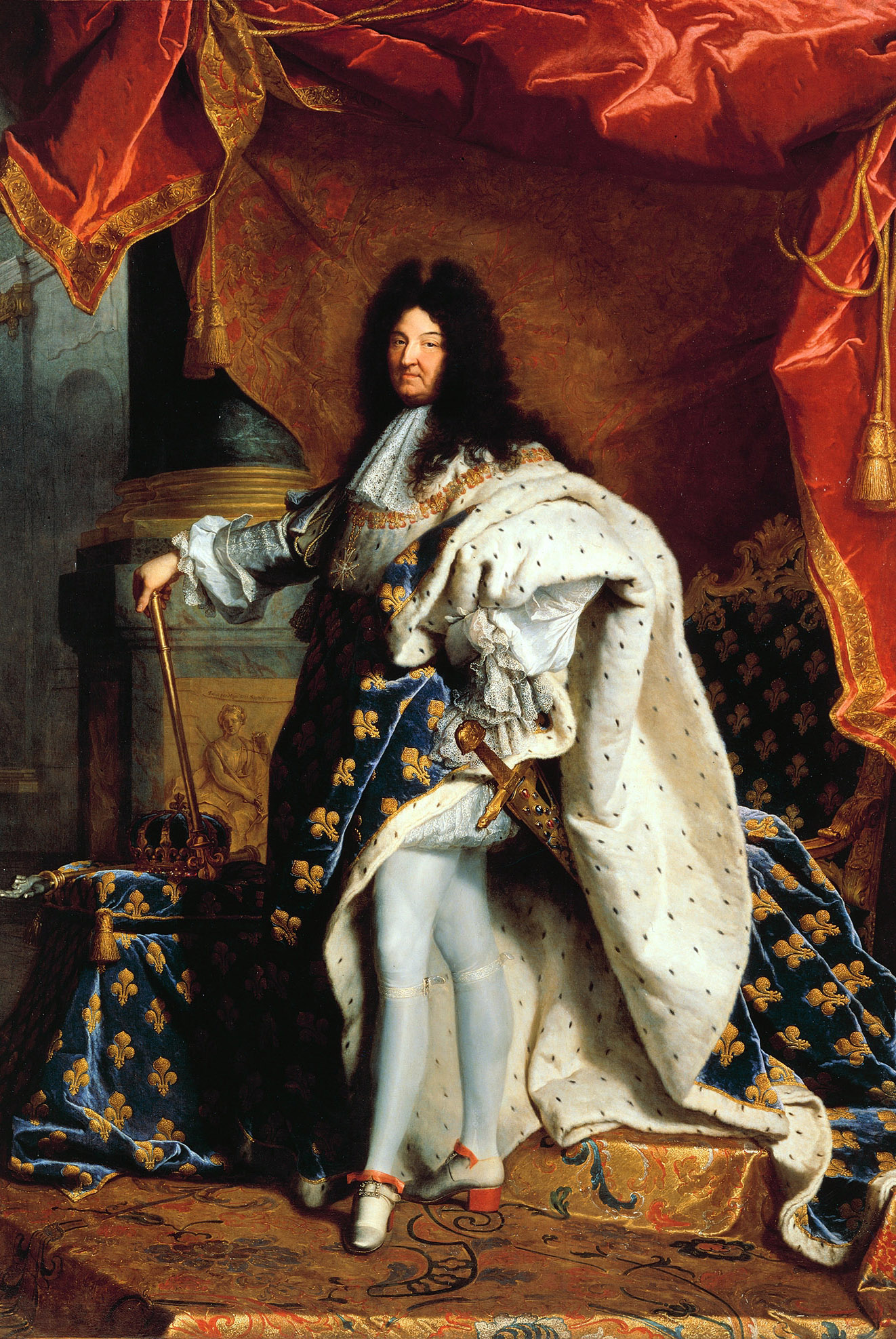
Louis XIV in 1701
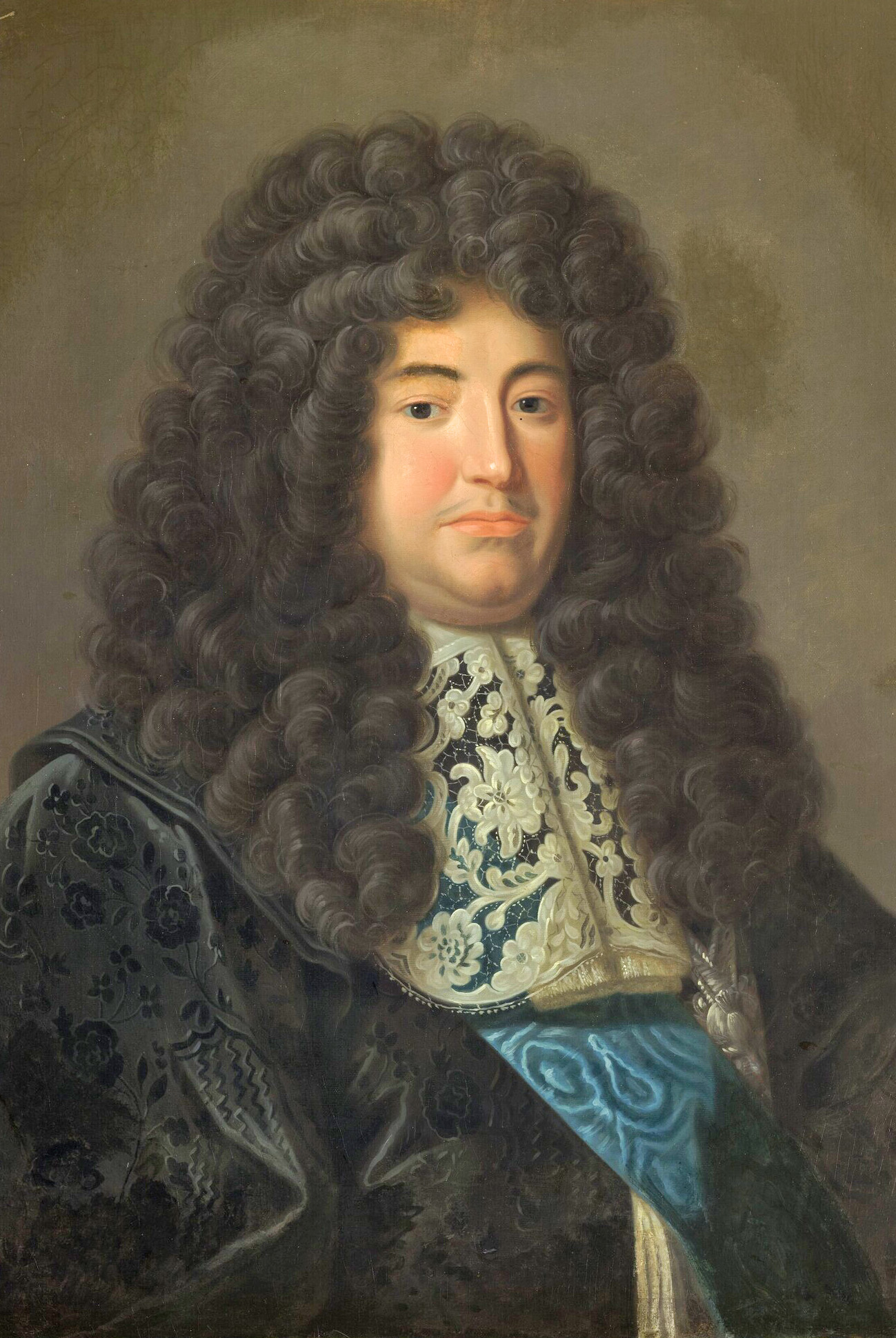
Portrait of Louvois
A Devastating Miscalculation
Louvois, Louis XIV’s minister, was convinced that this campaign of systematic destruction would establish a "defensive line on the Rhine," effectively protecting Alsace—recently annexed by France—from enemy incursions.
Speyer and Pforzheim were set ablaze, Heidelberg Castle was destroyed, and the cities of Mannheim, Worms, and Baden-Baden were devastated.
In hindsight, historians regard this decision as one of Louis XIV’s most significant strategic blunders.
Until 1689, public opinion in the Palatinate had been relatively favourable towards France, seen as "honest, humane, civilised, and opposed to barbarity."
But in the face of this heinous act, most German princes aligned themselves with the Habsburgs, whose influence was steadily growing across German territories.
Though Louis XIV may have won the war, the Sun King suffered a harsh political defeat!
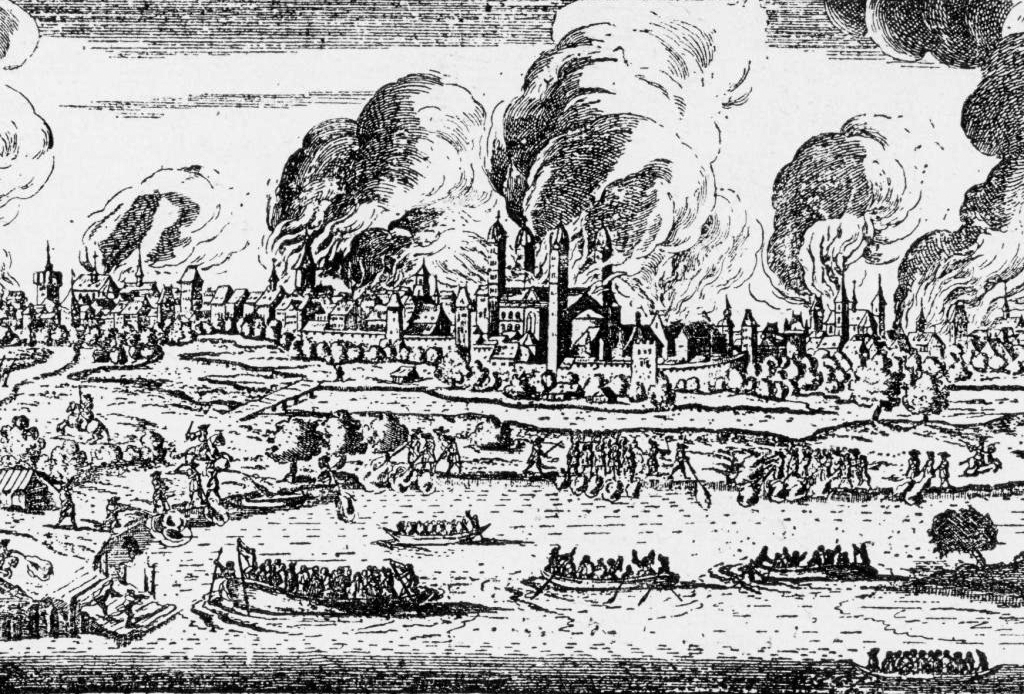
Le grand incendie de Spire en 1689
Speyer: A City Forever Changed by 1689
As we’ll see later, the great fire of 1689 had a profound and lasting impact on the urban development of Speyer:
- The partial destruction of the cathedral.
- The disappearance of Speyer’s old houses, followed by their reconstruction in the Baroque style during the 1700s and 1710s.
- The demolition of around sixty fortified towers and gates, with the notable exception of the Altpörtel.
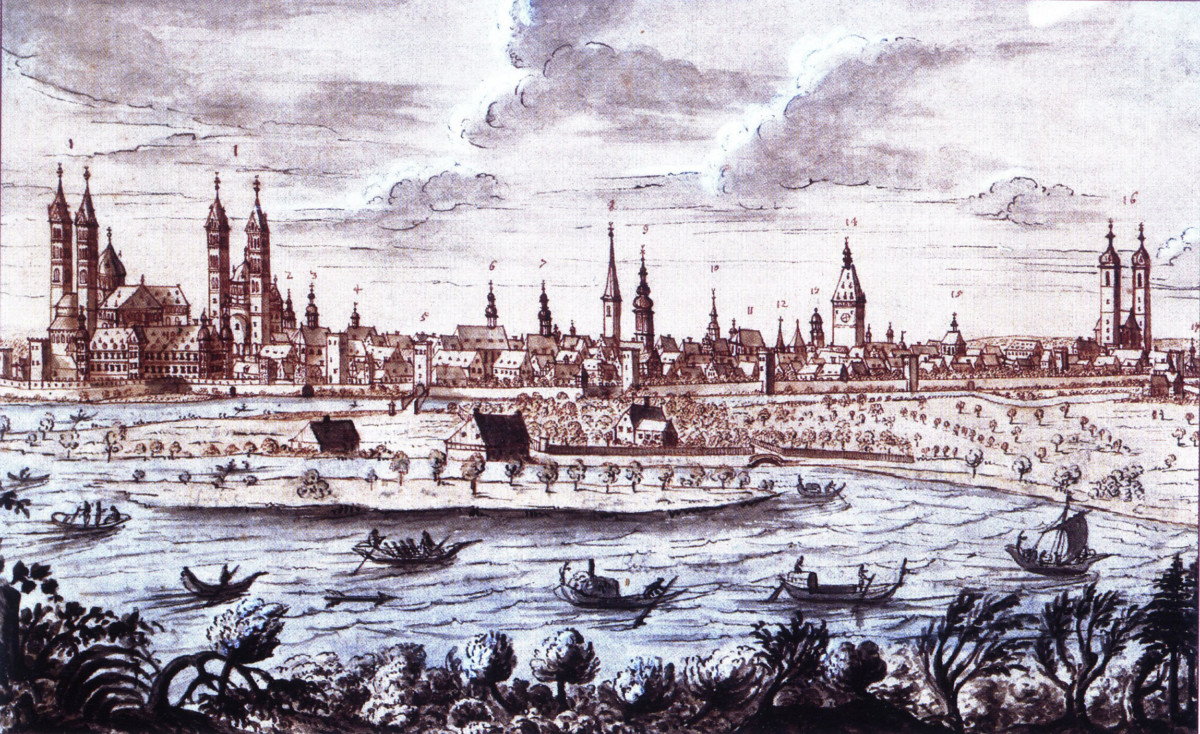
Speyer in 1750. See the cathedral still in ruins.
Franco-German Friendship in Speyer
Since 1959, Speyer has been twinned with Chartres, another city renowned for its cathedral.
The French cathedral is a masterpiece of Gothic art, while the German one is a jewel of Romanesque architecture.
Both cathedrals are also UNESCO World Heritage Sites.
![Chartres Cathedral © Benutzer Honge - licence [CC BY-SA 3.0] from Wikimedia Commons Chartres Cathedral © Benutzer Honge - licence [CC BY-SA 3.0] from Wikimedia Commons](https://frenchmoments.eu/wp-content/uploads/2025/01/Chartres-Cathedral-©-Benutzer-Honge-licence-CC-BY-SA-3.0-from-Wikimedia-Commons-scaled-1.jpg)
The chevet of Chartres Cathedral © Benutzer Honge - licence [CC BY-SA 3.0] from Wikimedia Commons
In addition, Speyer has twin city partnerships with the cathedral cities of Chichester (England) and Ravenna (Italy).
What makes this even more unique is that these four cities are twinned with each other.
Personally, Chichester is a city very close to where I live, and I know it quite well.
I even published a discovery article in French on my other blog, which focuses on exploring England, highlighting the city and its cathedral.
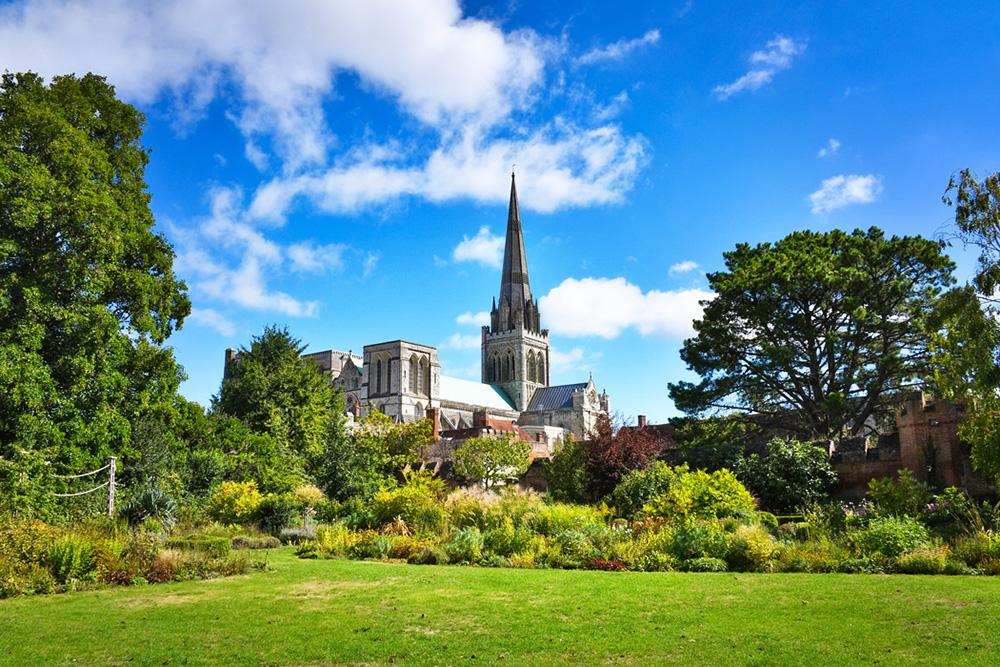
Chichester Cathedral © French Moments
Exploring Speyer, Germany
Visiting historic landmarks, strolling through the old streets, wandering in the parks and along the Rhine, and exploring the city’s museums... you’ll need at least a full day to take it all in!
![La vue de la porte sur la Maximilianstrasse et la cathédrale © AnRo0002 - licence [CC0] from Wikimedia Commons Speyer, Germany © AnRo0002 - licence [CC0] from Wikimedia Commons](https://frenchmoments.eu/wp-content/uploads/2025/01/Altpoertel-Speyer-View-©-AnRo0002-licence-CC0-from-Wikimedia-Commons.jpg)
The Maximilianstrasse and the cathedral © AnRo0002 - licence [CC0] from Wikimedia Commons
Speyer's Must-See Attractions
Here are the key monuments and sites to discover in Speyer, Germany:
- The Kaiserdom (Imperial Cathedral)
- The Altpörtel (Old City Gate)
- The Historical Museum of the Palatinate
- The Church of the Holy Trinity
- The Jewish Ritual Bath (Judenbad)
- The Gedächtniskirche (Memorial Church of the Protestation)
- The Technical Museum
- The Cathedral Park, leading to the banks of the Rhine
For this visit to Speyer, I suggest following a three-part itinerary, after which I’ll mention a few “off-route” sites worth a detour.
First Route – Imperial Speyer
From the Gedächtniskirche to the banks of the Rhine, passing the Altpörtel, Maximilianstraße, the Kaiserdom, and the Cathedral Park. Distance: 3 km.
Second Route – South of Maximilianstraße
From the Cathedral to the Altpörtel, including the Historical Museum of the Palatinate, the Judenbad (Jewish Ritual Bath), Königsplatz, and the Feuerbach House. Distance: 1.75 km.
Third Route – North of Maximilianstraße
From the Altpörtel to the Cathedral, passing through Korngasse and the picturesque Hasenpfuhl district. Distance: 1.5 km.
Route 1 - Imperial Speyer
- Length: Approximately 3 km
- Starting Point: Gedächtniskirche
- Ending Point: Domplatz
This first route takes us to discover the must-see landmarks of Speyer, Germany along its central axis: Maximilianstraße.
Let’s begin our visit at the entrance to Speyer with the Gedächtniskirche.
Entering Speyer
If you’re arriving from the south (Landau or Germersheim), you’ll enter Speyer via Landauerstraße.
On your left, you’ll pass part of the former Cité de France, where I lived for nearly a decade.
This area was home to the families of French soldiers from the FFA (Forces Françaises en Allemagne).
The buildings bore (and still bear) the names of former French provinces: Bourgogne, Lorraine, Champagne, Bretagne, Anjou, and so on.
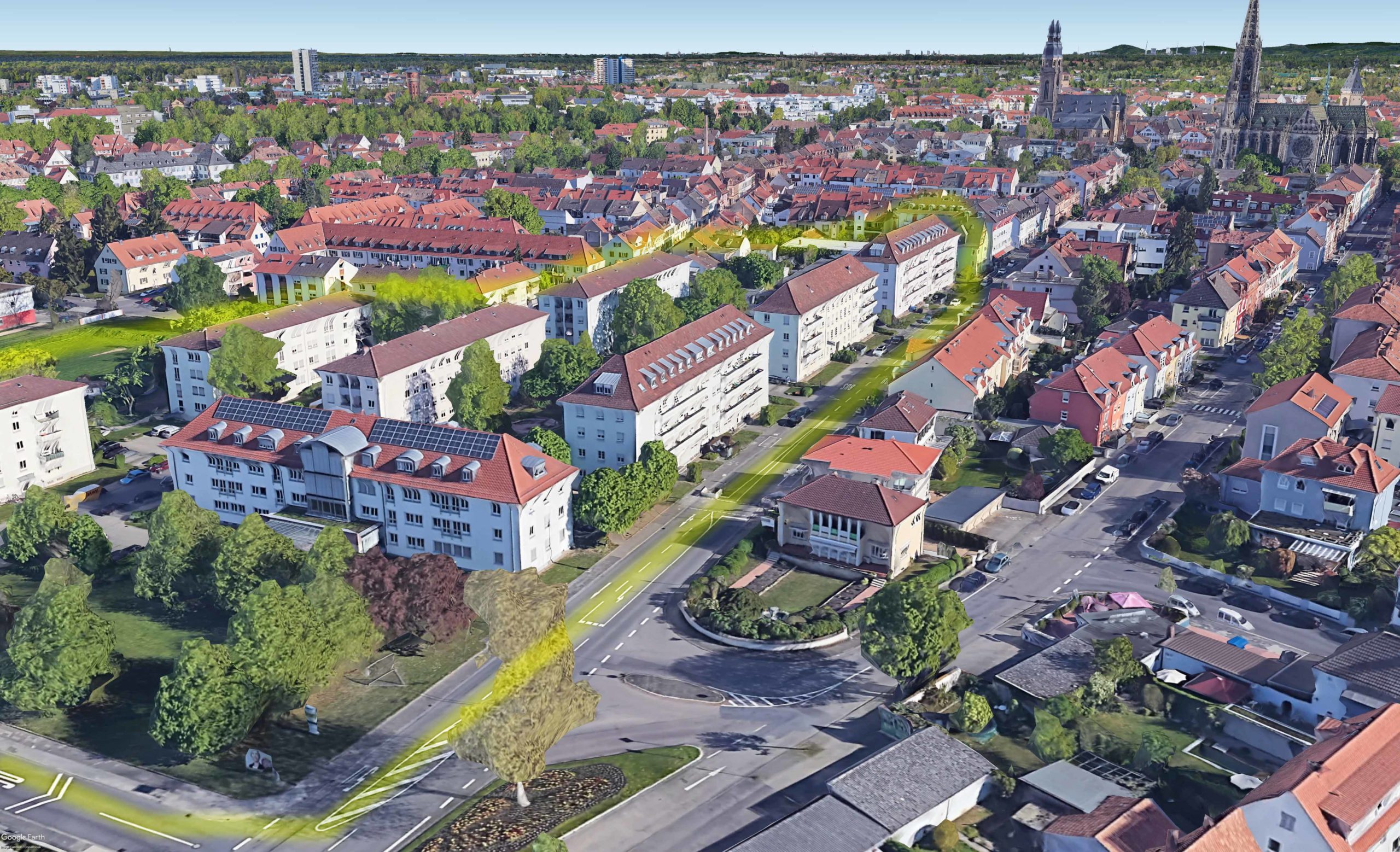
The buildings of the former *Cité de France* in Speyer, Germany, as seen on Google Earth.
The French presence in Speyer came to an end in the 1990s, following the fall of the Berlin Wall and German reunification.
The Gedächtniskirche: A Cathedral for Protestants
Our tour of Speyer begins impressively with this monumental church standing at the crossroads of the roads from Landau and Neustadt.
The Gedächtniskirche is a true gem of Gothic art—or more precisely, Neo-Gothic art.
![Gedaechtniskirche de la Landauerstrasse par Immanuel Giel [Public Domain] La Gedächtniskirche vue de la Landauerstrasse à Spire - par Immanuel Giel [Public Domain]](https://frenchmoments.eu/wp-content/uploads/2025/01/Gedaechtniskirche-de-la-Landauerstrasse-par-Immanuel-Giel-Public-Domain.jpg)
The Gedächtniskirche as seen from Landauerstrasse in Speyer - photo by Immanuel Giel [Public Domain]
For despite its appearance, the church doesn’t date back to the Middle Ages.
It was built between 1893 and 1904 as a memorial church commemorating the Protestation.
The Gedächtniskirche recalls the 1529 Diet of Speyer, a historic event during which most of the German prince-electors and free cities solemnly "protested" against the emperor's authority over matters of faith.
It was here in Speyer that opponents of the Reformation began calling Martin Luther's followers "Protestants," officially marking the division of Christianity into two branches: Catholics and Protestants.
The Architecture of the Gedächtniskirche
The Gedächtniskirche was built using stones from quarries in Alsace, which was under German rule at the time.
Its Neo-Gothic architecture contrasts sharply with the Romanesque style of the Imperial Cathedral.
The commemorative church draws inspiration from Gothic churches constructed in France during the 13th century.
![Gedaechtniskirche church © Gerd Eichmann - licence [CC BY-SA 4.0] from Wikimedia Commons Vue extérieure de la Gedächtniskirche © Gerd Eichmann - licence [CC BY-SA 4.0] from Wikimedia Commons](https://frenchmoments.eu/wp-content/uploads/2025/01/Gedaechtniskirche-church-©-Gerd-Eichmann-licence-CC-BY-SA-4.0-from-Wikimedia-Commons.jpg)
Exterior of the Gedächtniskirche © Gerd Eichmann - licence [CC BY-SA 4.0] from Wikimedia Commons
Its hexagonal tower porch is topped with an elegant spire reaching a height of 100 metres.
This makes it the tallest church in Speyer and the Palatinate, as well as the tallest church on the left bank of the Rhine between Strasbourg and Cologne.
Spared during both World Wars, the Gedächtniskirche in Speyer is considered the finest example of Neo-Gothic architecture in Germany.
Inside, take time to admire the stunning stained-glass windows, including those of the "Imperial Choir," donated by Emperor Wilhelm II, and the rose windows in the transept.
![Gedächtniskirche Kaiser Choir © Roman Eisele - licence [CC BY-SA 4.0] from Wikimedia Commons Le "chœur impérial" de la Gedächtniskirche © Roman Eisele - licence [CC BY-SA 4.0] from Wikimedia Commons](https://frenchmoments.eu/wp-content/uploads/2025/01/Gedachtniskirche-Kaiser-Choir-©-Roman-Eisele-licence-CC-BY-SA-4.0-from-Wikimedia-Commons.jpg)
The "Imperial Choir" inside the Gedächtniskirche © Roman Eisele - licence [CC BY-SA 4.0] from Wikimedia Commons
For more information, see my detailed article on the Gedächtniskirche.
St. Joseph’s Church: At the Heart of a Rivalry
The Catholic community of Speyer wasn’t about to let the Protestants build a monumental church without a response.
This friendly rivalry took shape with the construction of a nearby church: St. Joseph’s Church (Josephskirche).
![Le chevet de la Josephskirche à Spire - par Immanuel Giel [Public Domain] Le chevet de la Josephskirche à Spire - par Immanuel Giel [Public Domain]](https://frenchmoments.eu/wp-content/uploads/2025/01/Josephskirche-Speyer-by-Immanuel-Giel-Public-Domain.jpg)
The Chevet of the Josephskirche in Speyer, Germany - Photo by Immanuel Giel [Public Domain]
The first stone was laid on 9 June 1912, with construction completed in 1914.
St. Joseph’s Church is just as monumental but displays a completely different style—a blend of Baroque, Renaissance, Flamboyant Gothic, and Jugendstil.
In other words, St. Joseph’s stands out strikingly in the Speyer cityscape.
The church is dominated by massive bulbous towers rising to 90 metres—10 metres shorter than the Gedächtniskirche.
However, as critics of the Gedächtniskirche might point out, St. Joseph’s has two towers!
The church is dedicated to St. Joseph, the patron saint of the Rhineland Palatinate.
![Josephskirche Speyer © Gerd Eichmann - licence [CC BY-SA 4.0] from Wikimedia Commons La Josephskirche à Spire © Gerd Eichmann - licence [CC BY-SA 4.0] from Wikimedia Commons](https://frenchmoments.eu/wp-content/uploads/2025/01/Josephskirche-Speyer-©-Gerd-Eichmann-licence-CC-BY-SA-4.0-from-Wikimedia-Commons.jpg)
The Josephskirche in Speyer, Germany © Gerd Eichmann - licence [CC BY-SA 4.0] from Wikimedia Commons
Follow Gilgenstraße towards the Altpörtel to reach Postplatz.
The Postplatz
Postplatz (Post Square) takes its name from the former post office located to the left of the Altpörtel.
This impressive Neo-Baroque building was constructed in 1901.
Notice its Mansard roof, inspired by "French style," complete with oculus windows.
Since 2012, the decommissioned post office has been repurposed as a shopping centre.
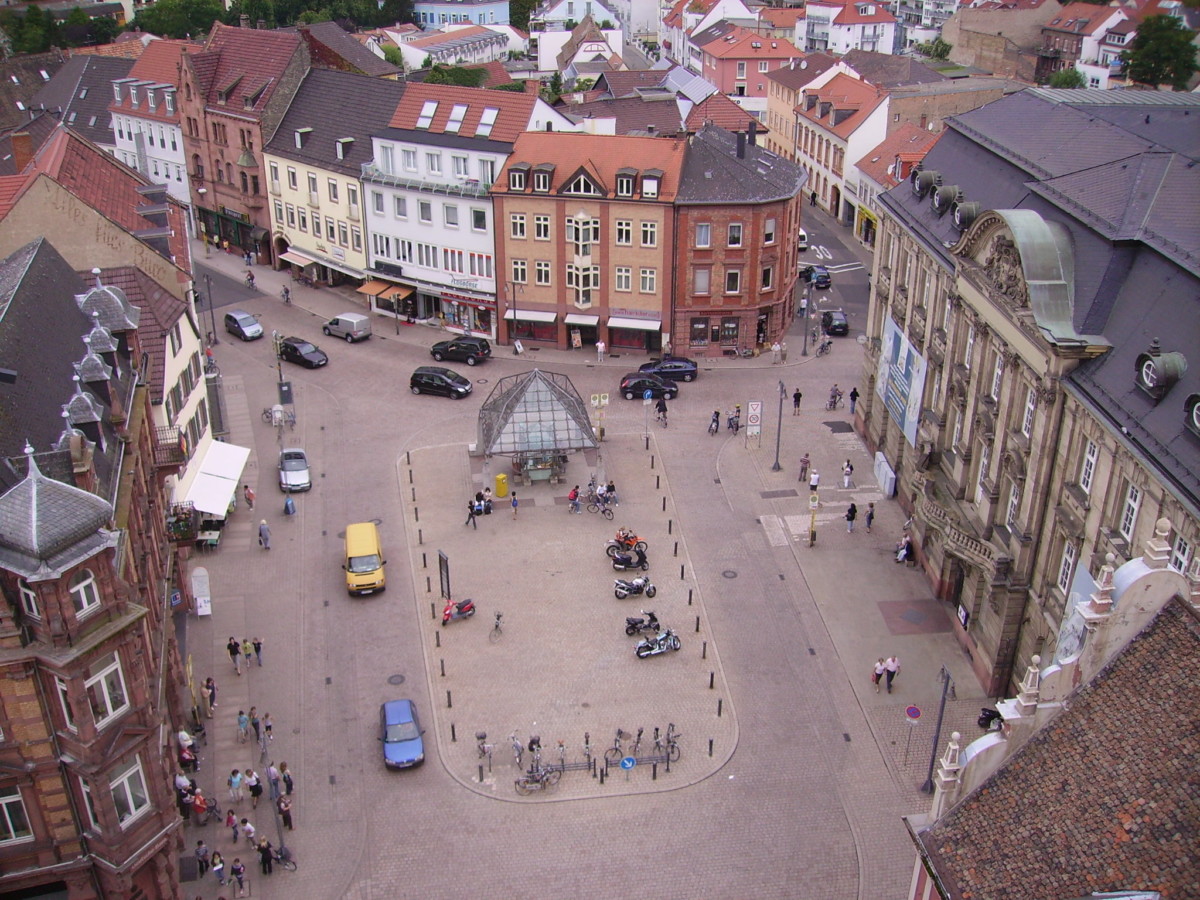
The Postplatz seen from the Altpörtel. Photo by Immanuel Giel (Public Domain)
The square is quite remarkable, showcasing three distinct architectural styles:
- Medieval (Altpörtel),
- Neo-Renaissance (the red building housing the Altpörtel-Café, built in 1860)
- and Neo-Baroque (the former post office).
![Hauptpost Speyer © AnRo0002 - licence [CC0] from Wikimedia Commons Poste centrale de Spire en Allemagne © AnRo0002 - licence [CC0] from Wikimedia Commons](https://frenchmoments.eu/wp-content/uploads/2025/01/Hauptpost-Speyer-©-AnRo0002-licence-CC0-from-Wikimedia-Commons-scaled-1.jpg)
The façade of Speyer's former post office © AnRo0002 - licence [CC0] from Wikimedia Commons
The Altpörtel: The Historic Gateway to Speyer’s Old Town
The Altpörtel (Old Gate) is one of the tallest (55 metres) and most significant city gates in Germany.
![Altpörtel de Spire Speyer © BlueBreezeWiki - licence [CC BY-SA 3.0] from Wikimedia Commons Altpörtel de Spire vue de la Postplatz © BlueBreezeWiki - licence [CC BY-SA 3.0] from Wikimedia Commons](https://frenchmoments.eu/wp-content/uploads/2025/01/Altportel-de-Spire-Speyer-©-BlueBreezeWiki-licence-CC-BY-SA-3.0-from-Wikimedia-Commons.jpg)
Speyer's Altpörtel seen from the Postplatz © BlueBreezeWiki - licence [CC BY-SA 3.0] from Wikimedia Commons
The lower section is, naturally, the oldest, constructed between 1230 and 1250.
The top floor, featuring a gallery with Late Gothic-style arcades, was added between 1512 and 1514.
Finally, the steep roof with dormer windows was installed in 1708, crowned with a large lantern.
The countryside-facing side of the Altpörtel is relatively austere, featuring arrow slits.
However, it is adorned with a double clock.
To its left stands a red gabled house with voluted edges, adding a Baroque touch to the otherwise medieval structure.
The city-facing side is less austere, displaying a more elaborate style than the countryside-facing side.
Two rows of wide windows are topped with a double clock.
![Altportel Speyer © Dickelbers - licence [CC BY-SA 3.0] from Wikimedia Commons L'Altpörtel côté ville © Dickelbers - licence [CC BY-SA 3.0] from Wikimedia Commons](https://frenchmoments.eu/wp-content/uploads/2025/01/Altportel-Speyer-©-Dickelbers-licence-CC-BY-SA-3.0-from-Wikimedia-Commons.jpg)
The Altpörtel as seen from the city side © Dickelbers - licence [CC BY-SA 3.0] from Wikimedia Commons
The tower was fortunately spared by Louis XIV’s troops in 1689 during the War of the Palatinate Succession.
Click here to learn more about the Altpörtel’s French connection.
The View from the Altpörtel
I highly recommend climbing the steps to the arcades. At 30 metres above the ground, you’ll be rewarded with stunning views of the city and its surroundings.
On one side, you’ll see the Gedächtniskirche and St. Joseph’s Church, with the Palatinate mountains stretching in the background from Landau to Bad Dürkheim.
![Speyer View from Altpörtel to Gedächtniskirche and St.Joseph © Roman Eisele - licence [CC BY-SA 4.0] from Wikimedia Commons La Gedächtniskirche et la Josephskirche vues de l'Altpörtel © Roman Eisele - licence [CC BY-SA 4.0] from Wikimedia Commons](https://mon-grand-est.fr/wp-content/uploads/2020/07/Speyer-View-from-Altpörtel-to-Gedächtniskirche-and-St.Joseph-©-Roman-Eisele-licence-CC-BY-SA-4.0-from-Wikimedia-Commons.jpg)
The Gedächtniskirche and Josephskirche seen from the Altpörtel © Roman Eisele - licence [CC BY-SA 4.0] from Wikimedia Commons
On the other side, you’ll spot the landmarks of Speyer’s historic centre lining both sides of Maximilianstraße, leading to the famous cathedral.
In the distance, you’ll see the mountains near Heidelberg and, to the north, the industrial areas of Ludwigshafen and Mannheim.
![Speyer---Altpörtel-©-Roman-Eisele---licence-[CC-BY-SA-4.0]-from-Wikimedia-Commons La cathédrale de Spire vue de l'Altpörtel © Roman Eisele - licence [CC BY-SA 4.0] from Wikimedia Commons](https://frenchmoments.eu/wp-content/uploads/2025/01/Speyer-Altportel-©-Roman-Eisele-licence-CC-BY-SA-4.0-from-Wikimedia-Commons.jpg)
Speyer Kaiserdom seen from the Altpörtel © Roman Eisele - licence [CC BY-SA 4.0] from Wikimedia Commons
Let’s cross to the other side of the Altpörtel and step into the historic centre of the former Imperial City.
Maximilianstraße: Speyer's Triumphal Avenue
In Speyer, there was no need for Haussmann to carve through the medieval urban fabric!
Since the 11th century, Speyer has had its Hauptstraße.
More than just a main street, it is a true Triumphal Way—a Via Triumphalis.
![Maximilianstraße Speyer © PQ3 - licence [CC BY-SA 3.0] from Wikimedia Commons La Maximilianstraße vue de l'Altpörtel © PQ3 - licence [CC BY-SA 3.0] from Wikimedia Commons](https://frenchmoments.eu/wp-content/uploads/2025/01/Maximilianstrase-Speyer-©-PQ3-licence-CC-BY-SA-3.0-from-Wikimedia-Commons.jpg)
Maximilianstraße seen from the Altpörtel © PQ3 - licence [CC BY-SA 3.0] from Wikimedia Commons
Stretching 700 metres, it is flanked by two iconic monuments: the Altpörtel to the west and the Kaiserdom (Imperial Cathedral) to the east.
During grand religious celebrations, the emperor and his court would walk along this street in solemn procession.
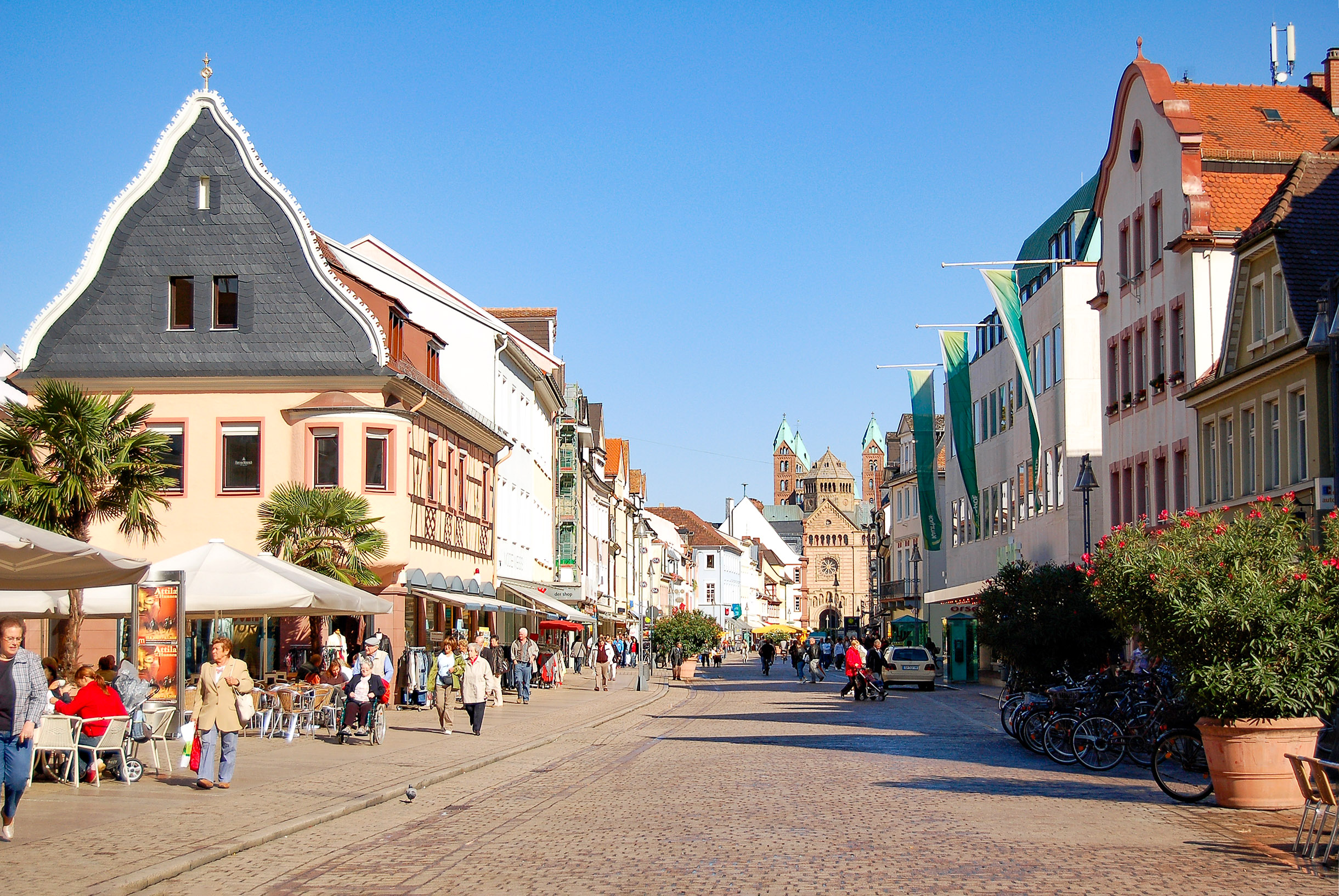
Speyer's Maximilianstrasse. Photo @F51C via Twenty20
Maximilian and His French Connection
In 1816, the street was named Maximilianstraße after Maximilian I (1756–1825), the first King of Bavaria.
Maximilian of Wittelsbach grew up in Strasbourg and also held the title of Count of Ribeaupierre (Ribeauvillé) in Alsace.
Interestingly, the godfather of his eldest son, Ludwig, was none other than Louis XVI.
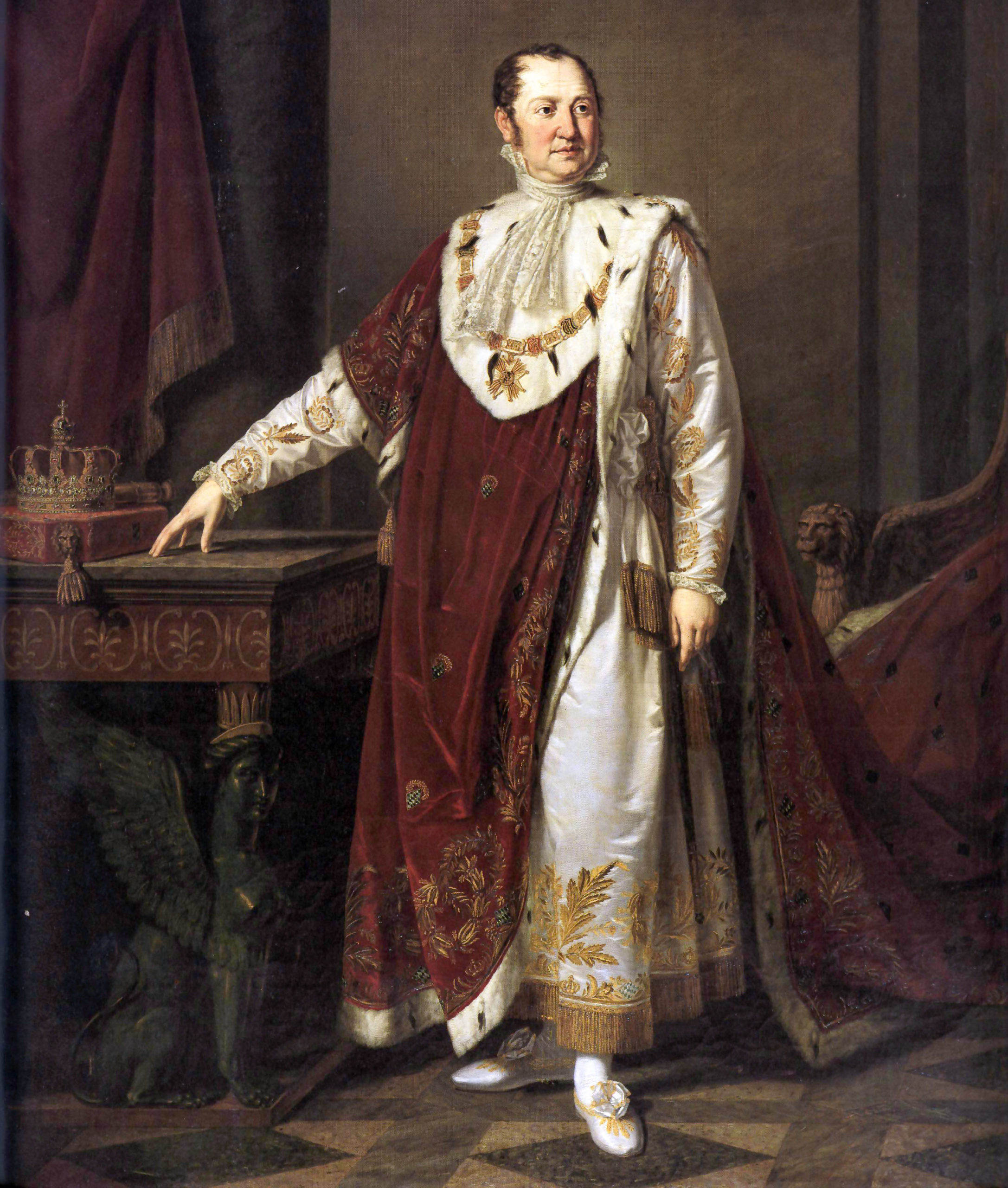
Maximilian of Wittelsbach, King of Bavaria, portrait from 1806
Today, Maximilianstraße serves as a bustling commercial hub, lined with numerous shops and boutiques.
Each December, Speyer’s Christmas market takes over the section of the street in front of the Alte Münze (the Old Mint).
The celebrations for Speyer’s 2,000th anniversary in 1990 marked a turning point, as the street was closed to car traffic.
This change paved the way for new café terraces to flourish.
Along the street, you’ll find traditional pretzel vendors, one of Speyer’s iconic symbols.
When I arrived in the early 1980s, these vendors operated from wooden stalls.
In 1990, to commemorate the city’s 2,000 years, the wooden structures were replaced by modern glass booths.
![Bretzel Stand in Speyer © Sundar1 - licence [CC BY-SA 3.0] from Wikimedia Commons La Maximilianstrasse à Spire © Sundar1 - licence [CC BY-SA 3.0] from Wikimedia Commons](https://frenchmoments.eu/wp-content/uploads/2025/01/Bretzel-Stand-in-Speyer-©-Sundar1-licence-CC-BY-SA-3.0-from-Wikimedia-Commons.jpg)
Pretzel stalls along Maximilianstraße in Speyer. © Sundar1 - licence [CC BY-SA 3.0] from Wikimedia Commons
Monuments along the Maximilianstraße
The street is lined with several gabled houses from the 18th century.
Their pastel-coloured façades lend a cheerful charm to this central thoroughfare in the heart of the city.
None of the houses date back to before 1689, as the city was set ablaze by French troops.
However, Speyer and its landmarks were fortunately spared from bombings during the Second World War.
The oldest houses (numbers 24, 25, 26, 27, 29, 30, 35, and 86) date from the early 1700s.
Many feature street-facing gabled roofs, occasionally adorned with volutes.
![Speyer Maximilianstraße 29 © Tilman2007 - licence [CC BY-SA 4.0] from Wikimedia Commons Nº29 Maximilianstraße © Tilman2007 - licence [CC BY-SA 4.0] from Wikimedia Commons](https://frenchmoments.eu/wp-content/uploads/2025/01/Speyer-Maximilianstrase-29-©-Tilman2007-licence-CC-BY-SA-4.0-from-Wikimedia-Commons-scaled-1.jpg)
Number 29 Maximilianstraße © Tilman2007 - licence [CC BY-SA 4.0] from Wikimedia Commons
![Speyer Maximilianstraße © Tilman2007 - licence [CC BY-SA 4.0] from Wikimedia Commons Nº25 Maximilianstraße © Tilman2007 - licence [CC BY-SA 4.0] from Wikimedia Commons](https://frenchmoments.eu/wp-content/uploads/2025/01/Speyer-Maximilianstrase-©-Tilman2007-licence-CC-BY-SA-4.0-from-Wikimedia-Commons-scaled-1.jpg)
Number 25 Maximilianstraße © Tilman2007 - licence [CC BY-SA 4.0] from Wikimedia Commons
There are very few half-timbered houses in Speyer (notably number 86, dating back to 1700 and in Late Baroque style).
After the fire of 1689, reconstruction favoured stone buildings over timber.
![Maximilianstrasse 86 Speyer © Manuae - licence [CC BY-SA 3.0] from Wikimedia Commons Maximilianstrasse 86 Speyer © Manuae - licence [CC BY-SA 3.0] from Wikimedia Commons](https://frenchmoments.eu/wp-content/uploads/2025/01/Maximilianstrasse-86-Speyer-©-Manuae-licence-CC-BY-SA-3.0-from-Wikimedia-Commons-scaled-1.jpg)
86 Maximilianstrasse © Manuae - licence [CC BY-SA 3.0] from Wikimedia Commons
Alte Münze
At number 90 Maximilianstraße, the Alte Münze (Old Mint) marks the midpoint of the avenue, situated between the *Altpörtel* and the cathedral.
![Alte Muenze Speyer © Immanuel Giel - licence [CC BY-SA 4.0] from Wikimedia Commons Spire en Allemagne - Alte Münze © Immanuel Giel - licence [CC BY-SA 4.0] from Wikimedia Commons](https://frenchmoments.eu/wp-content/uploads/2025/01/Alte-Muenze-Speyer-©-Immanuel-Giel-licence-CC-BY-SA-4.0-from-Wikimedia-Commons-scaled-1.jpg)
Alte Münze © Immanuel Giel - licence [CC BY-SA 4.0] from Wikimedia Commons
This is the Old Mint, where the minting house has stood since the Middle Ages.
The original building was destroyed in the fire of 1689 and replaced in 1748 with the current structure.
Over the centuries, it has served various purposes, including a shop, warehouse, and administrative building.
In 1874, the building was extended with the addition of a third gabled floor.
Dreifaltigkeitskirche
Set back slightly from the street, the Church of the Holy Trinity (Dreifaltigkeitskirche) is a must-see landmark in Speyer.
![Dreifaltigkeitskirche Speyer © W. Bulach - licence [CC BY-SA 4.0] from Wikimedia Commons La Dreifaltigkeitskirche à Spire © W. Bulach - licence [CC BY-SA 4.0] from Wikimedia Commons](https://frenchmoments.eu/wp-content/uploads/2025/01/Dreifaltigkeitskirche-Speyer-©-W.-Bulach-licence-CC-BY-SA-4.0-from-Wikimedia-Commons.jpg)
The Dreifaltigkeitskirche in Speyer, Germany © W. Bulach - licence [CC BY-SA 4.0] from Wikimedia Commons
The construction of this Lutheran church was a response to the destruction of Speyer by Louis XIV’s troops in 1689.
Reconstruction began when the first families returned from their refuge in Frankfurt am Main, a decade after the war.
The church’s design strongly references Frankfurt’s Katharinenkirche.
The foundation stone was laid in 1701, the main structure was completed by 1703, and the church was inaugurated in 1717.
Less than 80 years after its completion, Speyer’s main Lutheran church faced the fate of many religious sanctuaries during the French Revolution: desecration.
It wasn’t until Napoleon’s defeat and the subsequent reorganisation of German territories that ecclesiastical life began to rebuild and flourish.
Inside the Church
The interior of the church is particularly striking, with its incredible ornamentation.
This Protestant church features a wooden ceiling painted with scenes from the Old and New Testaments.
Take note of the intricately carved wooden decorations on the pulpit, altar, and the two-tiered galleries supported by pillars on three sides.
The church underwent a major restoration between 2015 and 2017.
![Dreifaltigkeitskirche Speyer © TeKaBe- licence [CC BY-SA 4.0] from Wikimedia Commons L'intérieur de la Dreifaltigkeitskirche de Spire © TeKaBe- licence [CC BY-SA 4.0] from Wikimedia Commons](https://frenchmoments.eu/wp-content/uploads/2025/01/Dreifaltigkeitskirche-Speyer-©-TeKaBe-licence-CC-BY-SA-4.0-from-Wikimedia-Commons.jpg)
L'intérieur de la Dreifaltigkeitskirche de Spire © TeKaBe- licence [CC BY-SA 4.0] from Wikimedia Commons
Rathaus
At number 12 stands the red façade of Speyer’s Town Hall.
This Late Baroque building was constructed between 1712 and 1726 on the site of the municipal chancery, which was destroyed in 1689.
The structure is topped with a Mansard roof.
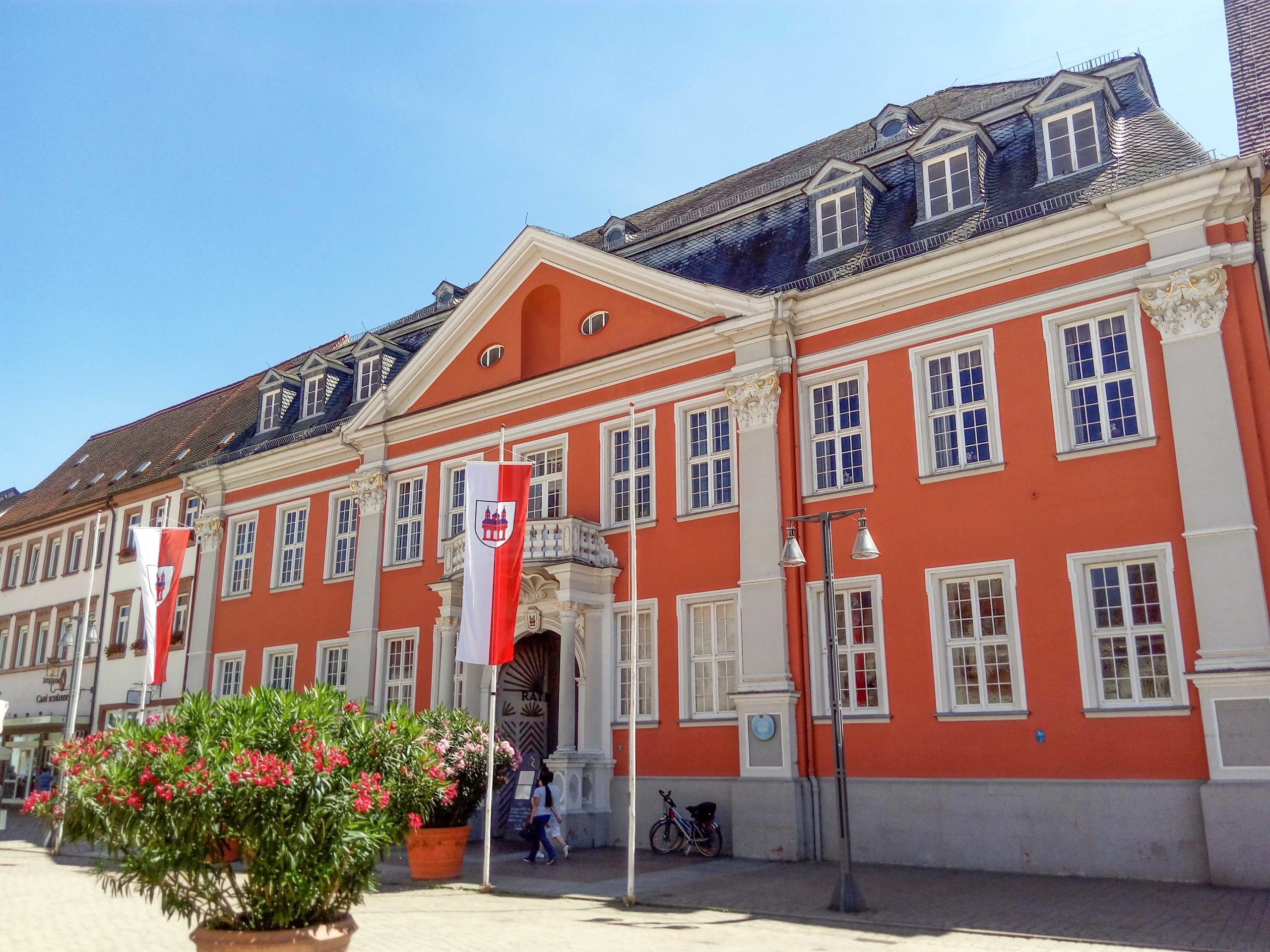
Speyer's Rathaus. Photo @agustin.19gonzalez via Twenty20
![Speyer Rathaus © Tilman2007 - licence [CC BY-SA 4.0] from Wikimedia Commons La Rathaus de Spire en Allemagne© Tilman2007 - licence [CC BY-SA 4.0] from Wikimedia Commons](https://frenchmoments.eu/wp-content/uploads/2025/01/Speyer-Rathaus-©-Tilman2007-licence-CC-BY-SA-4.0-from-Wikimedia-Commons-scaled-1.jpg)
The main entrance of the Rathaus © Tilman2007 - licence [CC BY-SA 4.0] from Wikimedia Commons
Stadthaus
At number 100, the imposing Stadthaus dates back to 1903.
Built from red sandstone sourced from quarries in Lorraine, it features a Neo-Baroque style and a Mansard roof.
Nicknamed "the Palace of Speyer" due to its monumental proportions and ornate façade, it was originally the headquarters of the Bavarian insurance company DRV.
Today, it houses Speyer’s municipal staff.
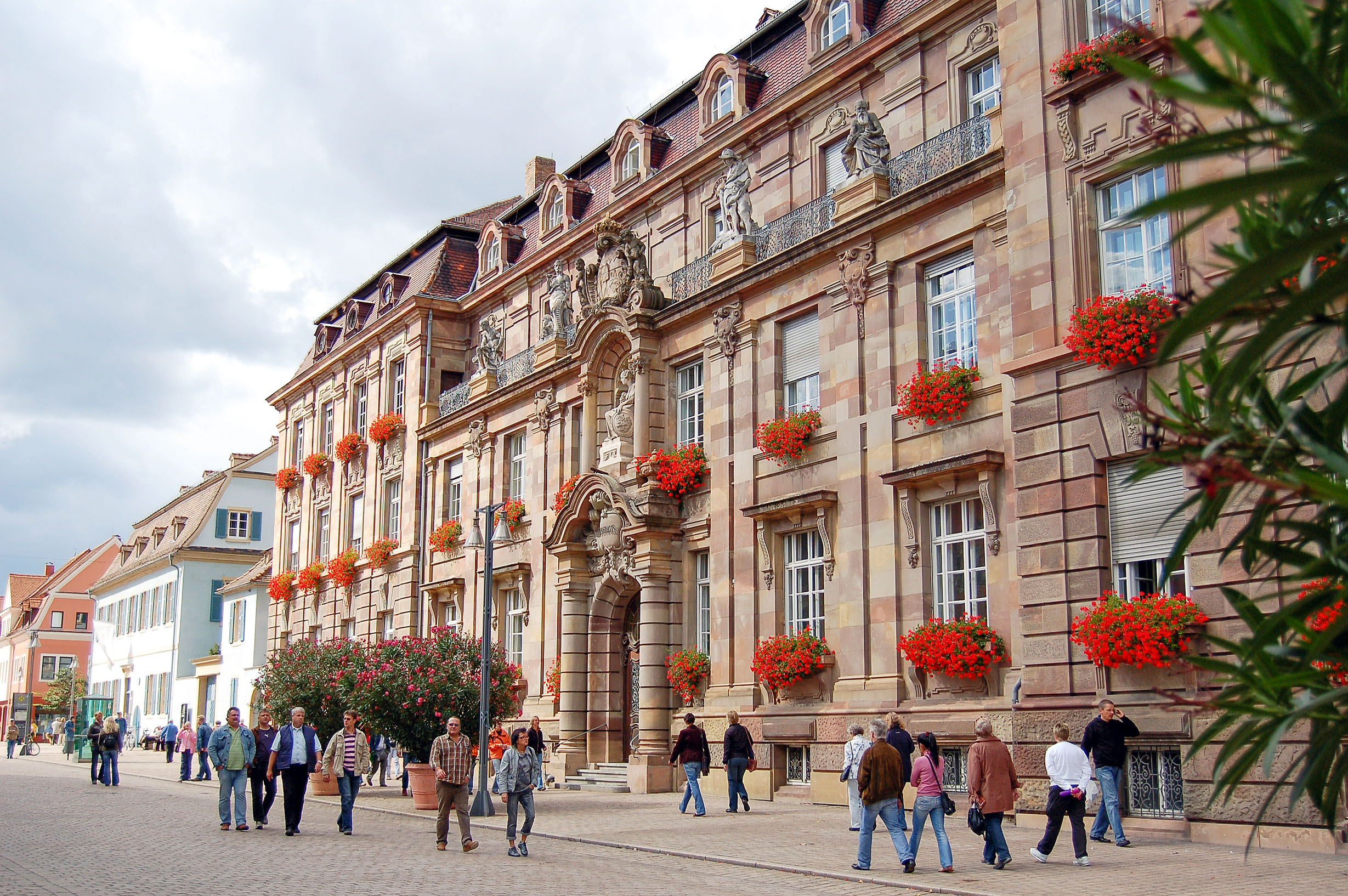
The Stadthaus in Speyer, Germany. Photo @F51C via Twenty20
Now that we’re in front of the cathedral, let’s pause for a moment in *Domplatz* and take a closer look at the enormous basin.
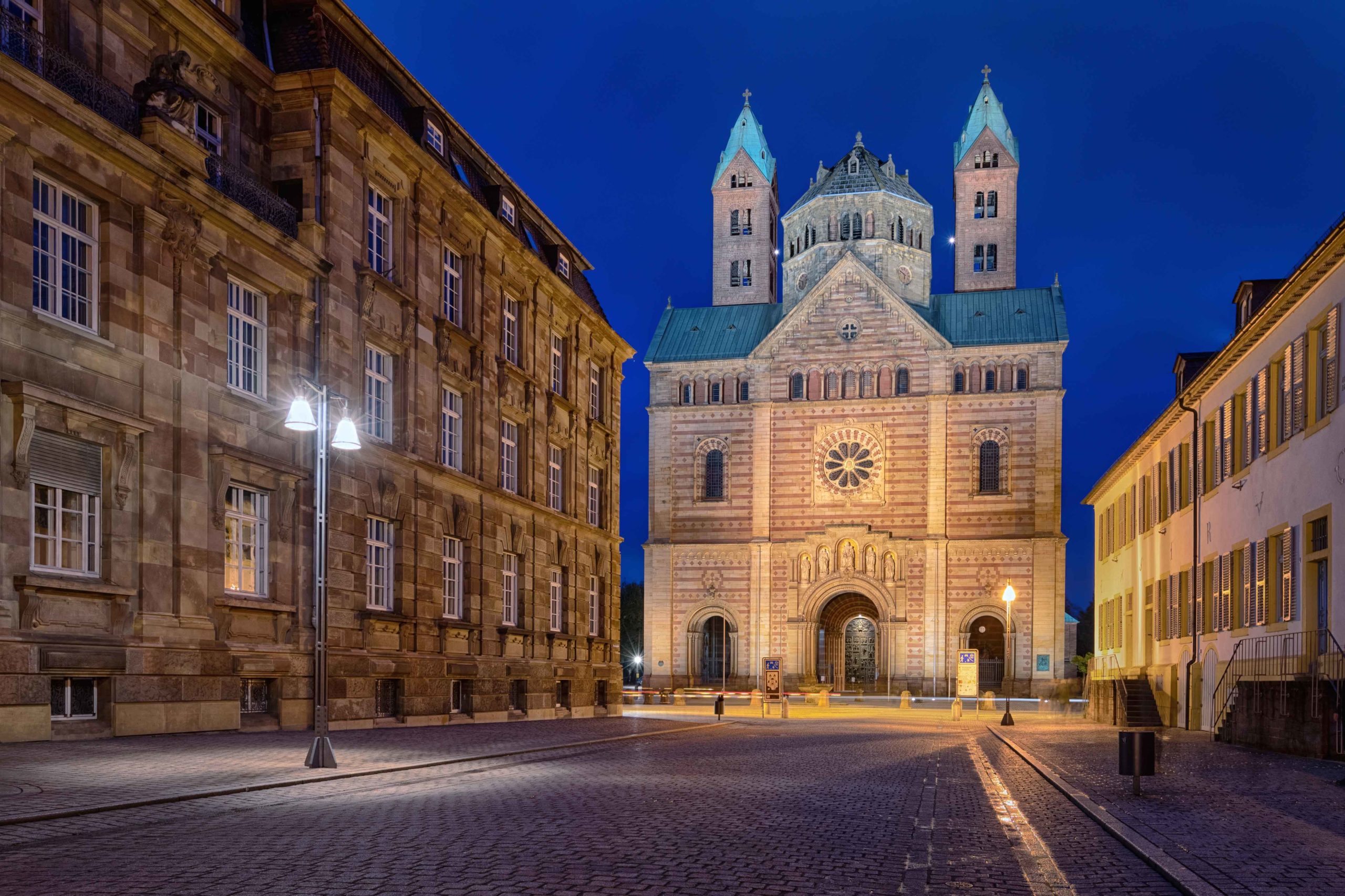
The cathedral of Speyer, Germany. Photo by bbsferrari via Envato Elements
The Domnapf
Do you see the large stone basin in front of the cathedral?
It’s called the Domnapf.
This basin was traditionally filled with wine during the ceremony to inaugurate a new bishop.
With a capacity of around 1,580 litres, every resident of Speyer had the right to partake in the wine.
![Speyer_Domplatz_Hauptortal_mit_Domnapf_und_Domkapitel_Wohnhaus-©-Matthias.kammerer---licence-[CC-BY-SA-4.0]-from-Wikimedia-Commons La place de la cathédrale (Domplatz) © Matthias.kammerer - licence [CC BY-SA 4.0] from Wikimedia Commons](https://frenchmoments.eu/wp-content/uploads/2025/01/Speyer_Domplatz_Hauptortal_mit_Domnapf_und_Domkapitel_Wohnhaus-©-Matthias.kammerer-licence-CC-BY-SA-4.0-from-Wikimedia-Commons.jpg)
Domplatz © Matthias.kammerer - licence [CC BY-SA 4.0] from Wikimedia Commons
It is believed to date back to 1294, although the first documented mention of it appears "only" in 1314.
Upon closer inspection, you’ll notice that it is shaped like a flat cup.
The basin is adorned with bas-reliefs of various coats of arms, including that of the Bishop of Speyer.
A scallop shell on the basin marks Speyer as a starting point for the Camino de Santiago (Saint James’s Way).
![Domnapf-Speyer-©-AnRo0002---licence-[CC0]-from-Wikimedia-Commons Le coquillage du Domnapf à Spire © AnRo0002 - licence [CC0] from Wikimedia Commons](https://frenchmoments.eu/wp-content/uploads/2025/01/Domnapf-Speyer-©-AnRo0002-licence-CC0-from-Wikimedia-Commons.jpg)
The scallop shell on the Domnapf © AnRo0002 - licence [CC0] from Wikimedia Commons
The Latin Inscription
![Domnapf Speyer © BlueBreezeWiki - licence [CC BY-SA 3.0] from Wikimedia Commons Domnapf - Spire en Allemagne © BlueBreezeWiki - licence [CC BY-SA 3.0] from Wikimedia Commons](https://frenchmoments.eu/wp-content/uploads/2025/01/Domnapf-Speyer-©-BlueBreezeWiki-licence-CC-BY-SA-3.0-from-Wikimedia-Commons.jpg)
Detail of the Domnapf © BlueBreezeWiki - licence [CC BY-SA 3.0] from Wikimedia Commons
A Latin inscription runs along the upper edge of the Domnapf, explaining its purpose:
Quid velit haec, relegas, ut lanx cavus individuelle catinus;
Dum novus antistes procerum comitante caterva - Urbem hanc intrat eques, huc Bacchi munera fundit;
Virginis a templo cleri simul ecclesiarum - Terminus et limes, asile stat libertatis;
Et fit confugium, portus et ara riz. 1490
In plain English, it translates to:
If you wish to understand this, read carefully: this basin, hollow like a deep dish, serves its purpose.
When a new bishop enters the city on horseback, accompanied by a retinue of noblemen, the gifts of Bacchus (wine) are poured into it.
From the Virgin’s temple to the churches, this marks the boundary and limit of clerical authority.
It is also a sanctuary, a refuge, a harbour, and an altar of peace.
1490
Indeed, the Domnapf originally marked the boundary between the Free Imperial City of Speyer and the cathedral’s zone of immunity.
A guilty party (or criminal) who managed to cross the Domnapf’s boundary could no longer be pursued by the city authorities.
This was how the right of asylum of the episcopal city was upheld.
![Domnapf-Speyer-©-BlueBreezeWiki---licence-[CC-BY-SA-3.0]-from-Wikimedia-Commons Le Domnapf à Spire © BlueBreezeWiki - licence [CC BY-SA 3.0] from Wikimedia Commons](https://frenchmoments.eu/wp-content/uploads/2025/01/Domnapf-Speyer-©-BlueBreezeWiki-licence-CC-BY-SA-3.0-from-Wikimedia-Commons-1.jpg)
The Domnapf in Speyer © BlueBreezeWiki - licence [CC BY-SA 3.0] from Wikimedia Commons
It’s now time to explore the famous Imperial Cathedral of Speyer.
The Kaiserdom
The Kaiserdom (imperial cathedral) is the symbol of the city of Speyer.
![Aerial_photograph_Speyer_Cathedral-©-Kai-Scherrer---licence-[CC0]-from-Wikimedia-Commons La cathédrale de Spire vue du ciel © Kai Scherrer - licence [CC0] from Wikimedia Commons](https://frenchmoments.eu/wp-content/uploads/2025/01/Aerial_photograph_Speyer_Cathedral-©-Kai-Scherrer-licence-CC0-from-Wikimedia-Commons.jpg)
Speyer cathedral from above © Kai Scherrer - licence [CC0] from Wikimedia Commons
According to the wishes of its founder, Emperor Conrad II of the Salian dynasty, the Speyer Cathedral was the largest monument of its time.
As a testament to the piety of the emperors who commissioned it, it remains to this day a powerful medieval symbol of Christianity.
From 1039 and for nearly 300 years, the cathedral served as the burial site for eight kings and emperors of the Holy Roman Empire, as well as three empresses and an imperial princess.
It is rightly referred to as the "Imperial Cathedral" (Dom zu Speyer).
More than any other monument in Germany, it evokes the legacy of the Holy Roman Empire.
Glorious names from German dynasties are tied to its history: the Salians, the Hohenstaufens, the Habsburgs, and the Nassaus.
![Speyer_Dom-©-AnRo0002---licence-[CC0]-from-Wikimedia-Commons L'aigle bicéphale (façade occidentale) © AnRo0002 - licence [CC0] from Wikimedia Commons](https://frenchmoments.eu/wp-content/uploads/2025/01/Speyer_Dom-©-AnRo0002-licence-CC0-from-Wikimedia-Commons.jpg)
The Double-Headed Eagle (Western Façade) © AnRo0002 - licence [CC0] from Wikimedia Commons
A Quick Tour of the Cathedral
Facing Maximilianstraße, the western façade, inspired by Neo-Romanesque design, is a reconstruction from 1854–1858.
It stands out with its alternating red and yellow stones, a nod to the Romanesque-Salian era.
![Dom_zu_Speyer-©-Shesmax---licence-[CC-BY-SA-4.0]-from-Wikimedia-Commons La cathédrale de Spire © Shesmax - licence [CC BY-SA 4.0] from Wikimedia Commons](https://frenchmoments.eu/wp-content/uploads/2025/01/Dom_zu_Speyer-©-Shesmax-licence-CC-BY-SA-4.0-from-Wikimedia-Commons.jpg)
Speyer Cathedral © Shesmax - licence [CC BY-SA 4.0] from Wikimedia Commons
Be sure to walk around the cathedral through the park to admire the stunning Romanesque Lombard-style apse, one of the most beautiful in Europe.
The elegant apse forms an architectural masterpiece of unparalleled beauty, harmoniously blending with the two towers and the central dome.
![Speyer_-_Dom_-_Ansicht_der_Ostfassade_durch_Bogen-©-Roman-Eisele---licence-[CC-BY-SA-4.0]-from-Wikimedia-Commons La cathédrale de Spire vue sous l'arche de la tour des Païens © Roman Eisele - licence [CC BY-SA 4.0] from Wikimedia Commons](https://frenchmoments.eu/wp-content/uploads/2025/01/Speyer_-_Dom_-_Ansicht_der_Ostfassade_durch_Bogen-©-Roman-Eisele-licence-CC-BY-SA-4.0-from-Wikimedia-Commons.jpg)
The Speyer Cathedral as seen through the arch of the Heidentürm. © Roman Eisele - licence [CC BY-SA 4.0] from Wikimedia Commons
The crypt, consecrated in 1041, lies beneath the transept and choir.
It is the largest Romanesque columned hall in Europe.
Check out my detailed article on the Imperial Cathedral of Speyer.
![Speyer-Dom-Krypta-©-Tilman2007---licence-[CC-BY-SA-4.0]-from-Wikimedia-Commons La crypte romane de la cathédrale de Spire © Tilman2007 - licence [CC BY-SA 4.0] from Wikimedia Commons](https://frenchmoments.eu/wp-content/uploads/2025/01/Speyer-Dom-Krypta-©-Tilman2007-licence-CC-BY-SA-4.0-from-Wikimedia-Commons.jpg)
The Romanesque crypt of the Kaiserdom © Tilman2007 - licence [CC BY-SA 4.0] from Wikimedia Commons
The Cathedral's Park
The impressive Romanesque cathedral is surrounded by a vast park (Domgarten), which stretches all the way to the Rhine.
![Speyer-Domgarten-Heidentuermchen-©-Kmtextor---licence-[CC-BY-SA-4.0]-from-Wikimedia-Commons Dans le parc de la cathédrale de Spire © Kmtextor - licence [CC BY-SA 4.0] from Wikimedia Commons](https://frenchmoments.eu/wp-content/uploads/2025/01/Speyer-Domgarten-Heidentuermchen-©-Kmtextor-licence-CC-BY-SA-4.0-from-Wikimedia-Commons.jpg)
The Cathedral's Park © Kmtextor - licence [CC BY-SA 4.0] from Wikimedia Commons
Founded in 1821 by Carl Albert Leopold Freiherr von Stengel, the Cathedral Garden (Domgarten) is now the largest park in Speyer.
In the past, numerous religious and administrative buildings surrounded it, offering a better perspective of the cathedral’s remarkable length—over 133 metres!
In front of the cathedral, you’ll find a 1:100 scale model of the Kaiserdom. It is particularly designed for visually impaired visitors.
![Speyer_-_Dom_-_Ansicht_der_Ostfassade_durch_Bogen-©-Roman-Eisele---licence-[CC-BY-SA-4.0]-from-Wikimedia-Commons La cathédrale de Spire vue sous l'arche de la tour des Païens © Roman Eisele - licence [CC BY-SA 4.0] from Wikimedia Commons](https://frenchmoments.eu/wp-content/uploads/2025/01/Speyer_-_Dom_-_Ansicht_der_Ostfassade_durch_Bogen-©-Roman-Eisele-licence-CC-BY-SA-4.0-from-Wikimedia-Commons.jpg)
Speyer Cathedral © Roman Eisele - licence [CC BY-SA 4.0] from Wikimedia Commons
The Mount of Olives
The Mount of Olives (Ölberg) was constructed between 1505 and 1512 by Jans Seyffer of Heilbronn.
It originally stood at the centre of the cathedral cloister’s inner courtyard.
The sculptural group depicts the arrest of Jesus in the Garden of Gethsemane.
A roof was added in the 19th century to protect the statues, which had already suffered the effects of time.
![Oelberg-Speyer-by-Immanuel-Giel-[Public-Domain] Le Mont des Oliviers (Ölberg). Photo : Immanuel Giel [Domaine Public]](https://frenchmoments.eu/wp-content/uploads/2025/01/Oelberg-Speyer-by-Immanuel-Giel-Public-Domain.jpg)
The Mount of Olives (Ölberg). Photo : Immanuel Giel [Domaine Public]
The Tower of the Pagans
The Tower of the Pagans (Heidentürmchen) is a remnant of Speyer’s medieval fortifications, built around 1280.
This structure includes two stair turrets and served as part of the city’s defences.
Of the 68 towers that once lined Speyer’s city walls, it is one of only two gateways to have survived, along with the Altpörtel.
![Heidentuermchen_Speyer-by-Immanuel-Giel-[Public-Domain] La tour des Païens. Photo : Immanuel Giel [Domaine public]](https://frenchmoments.eu/wp-content/uploads/2025/01/Heidentuermchen_Speyer-by-Immanuel-Giel-Public-Domain.jpg)
The Tower of the Pagans. Photo : Immanuel Giel [Domaine public]
The Banks of the Rhine
This first tour concludes at the banks of the Rhine.
You can reach the river in two ways: either via a footbridge crossing Schillerweg (to the left of the Tower of the Pagans) or by following Rheinallee.
![Speyer-Rhein-©-AnRo0002---licence-[CC0]-from-Wikimedia-Commons La cathédrale de Spire et le Rhin © AnRo0002 - licence [CC0] from Wikimedia Commons](https://frenchmoments.eu/wp-content/uploads/2025/01/Speyer-Rhein-©-AnRo0002-licence-CC0-from-Wikimedia-Commons.jpg)
Speyer Cathedral and the Rhine © AnRo0002 - licence [CC0] from Wikimedia Commons
Route 2 - South of Maximilianstraße
- Length : Approximately 1,75 km
- Starting Point : Domplatz
- Ending Point : Postplatz
Our second tour of Speyer takes us to the districts located south of Maximilianstraße, where we’ll explore culturally significant sites like the Historical Museum of the Palatinate and ancient landmarks such as the Jewish Ritual Bath (Judenbad).
The Vicariat Courtyard
Opposite the cathedral stands the Episcopal Palace (Vikarienhof), the former seat of the vicariat.
This complex consists of three wings in Late Baroque style, featuring hipped roofs.
It was built around 1704 and later renovated in 1821.
![Speyer Vikarienhof © Gerd Eichmann - licence [CC BY-SA 4.0] from Wikimedia Commons Le Vikarienhof à Spire en Allemagne© Gerd Eichmann - licence [CC BY-SA 4.0] from Wikimedia Commons](https://frenchmoments.eu/wp-content/uploads/2025/01/Speyer-Vikarienhof-©-Gerd-Eichmann-licence-CC-BY-SA-4.0-from-Wikimedia-Commons-scaled-1.jpg)
Vikarienhof in Speyer, Germany © Gerd Eichmann - licence [CC BY-SA 4.0] from Wikimedia Commons
The Former Protestant Consistory
The beautiful building of the former Protestant Consistory dates back to 1893–1894.
With its representative Neo-Renaissance architecture, this sandstone structure with two wings now houses the Council of the Protestant Church of the Palatinate (Evangelische Kirche der Pfalz Landeskirchenrat).
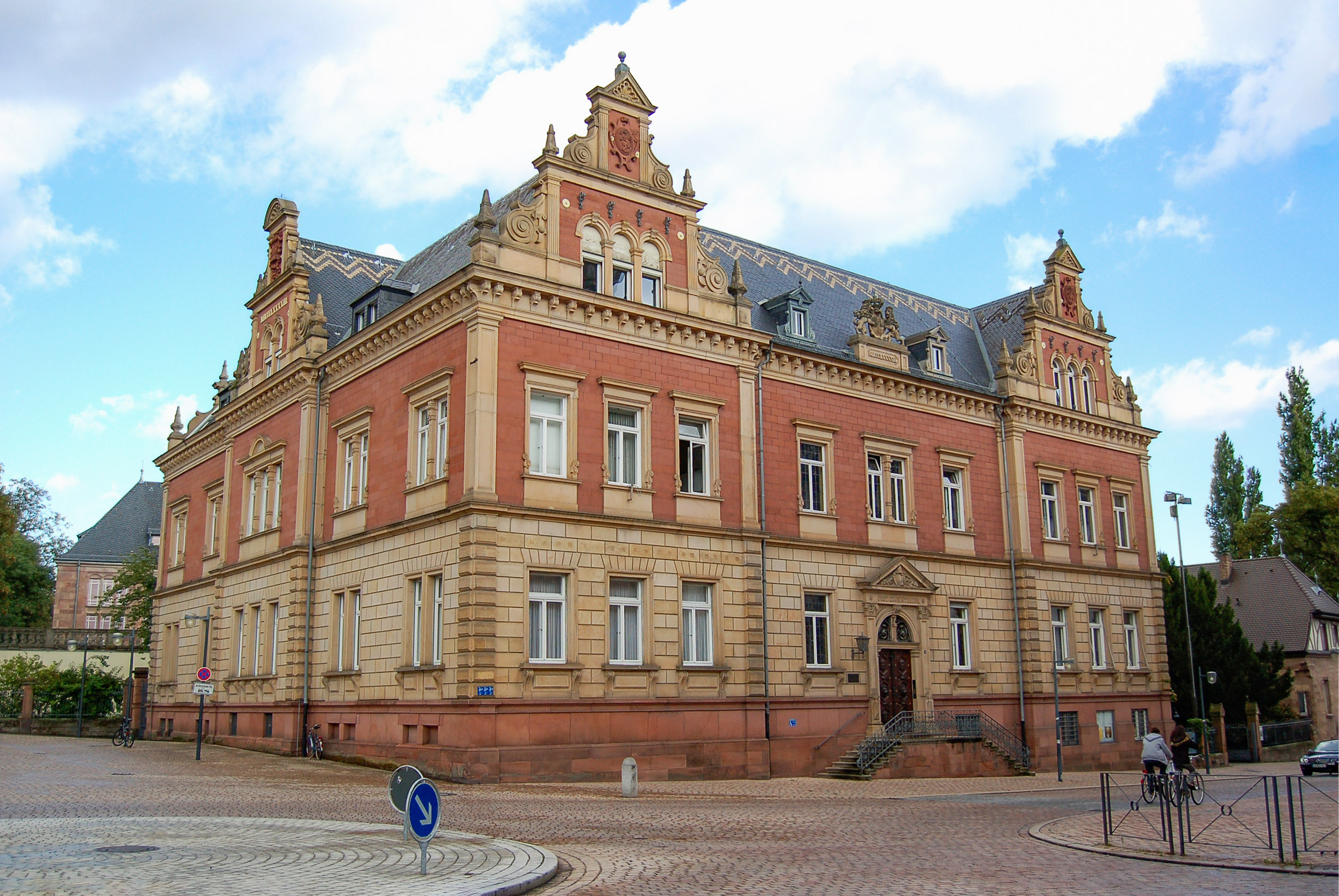
The Landeskirchenrat. Photo @F51C via Twenty20
The Historical Museum of the Palatinate
Near the cathedral stands an imposing building.
With its two turrets flanking the entrance, it could easily be mistaken for a castle.
However, it was constructed between 1907 and 1910 by Gabriel von Seidl specifically to house the Historical Museum of the Palatinate (Historische Museum der Pfalz).
![Speyer Historisches Museum © Dontworry - licence [CC BY-SA 3.0] from Wikimedia Commons Le musée du Palatinat à Spire en Allemagne © Dontworry - licence [CC BY-SA 3.0] from Wikimedia Commons](https://frenchmoments.eu/wp-content/uploads/2025/01/Speyer-Historisches-Museum-©-Dontworry-licence-CC-BY-SA-3.0-from-Wikimedia-Commons-scaled-1.jpg)
The Historical Museum of the Palatinate © Dontworry - licence [CC BY-SA 3.0] from Wikimedia Commons
The museum is one of the most significant historical museums in Germany, attracting nearly 200,000 visitors annually and featuring an exhibition space of 8,000 m².
In 1990, the museum was expanded at the rear with the addition of a glass roof shaped like two pyramids—a possible nod to the Louvre Pyramid, inaugurated in Paris just a year earlier?
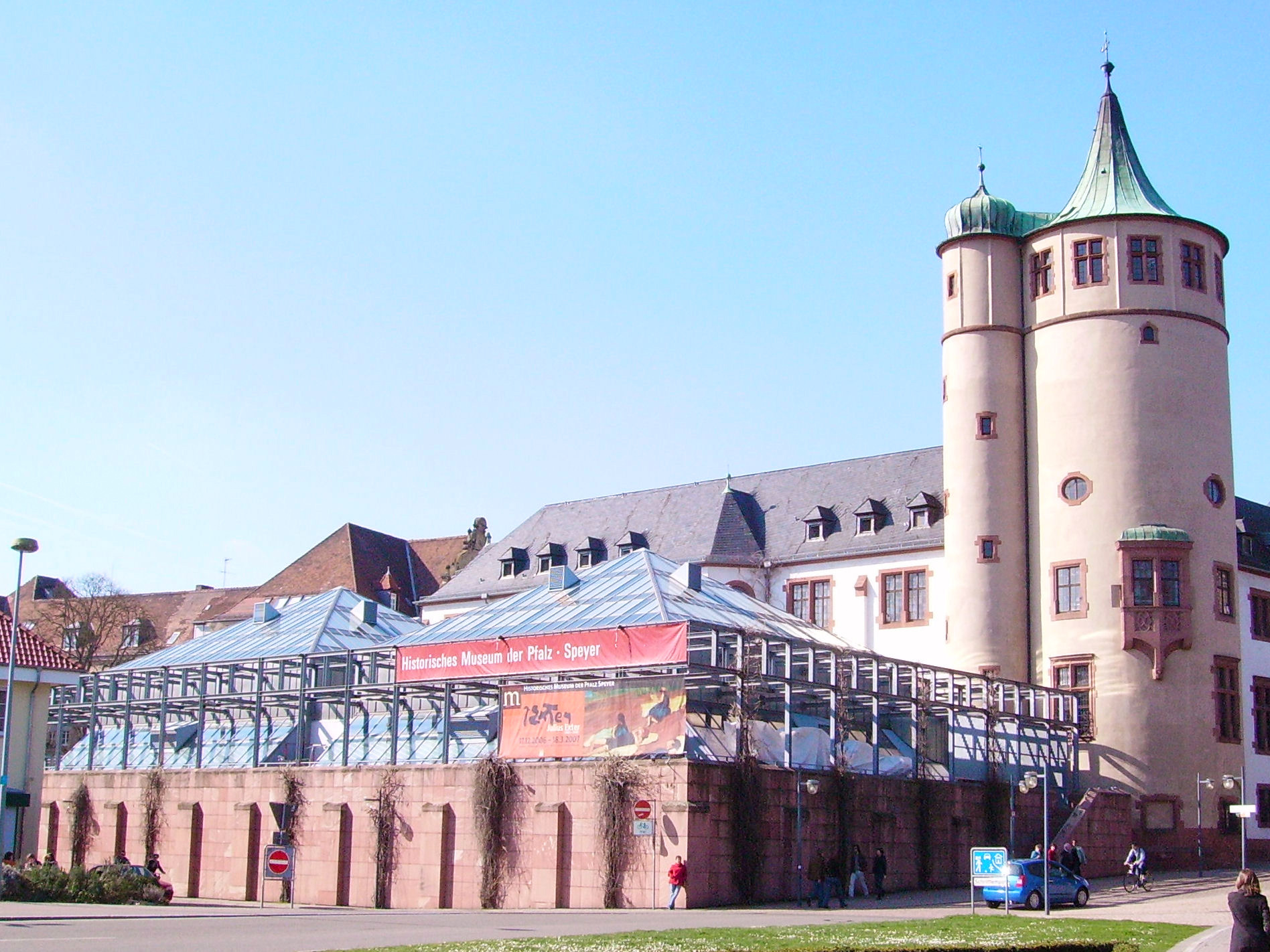
The Glass Pyramids of the Historical Museum of the Palatinate. Photo by Immanuel Giel (Domaine public)
The museum features numerous permanent collections, showcasing the cultural history of the Palatinate, including:
Prehistory of the Palatinate
This section documents the cultural, social, and economic development of the region, from the earliest traces of human presence up to the eve of Roman occupation.
Here, you’ll discover artistic golden jewellery, including the centrepiece of the collection: the famous Schifferstadt Gold Hat.
Dating back to the Bronze Age, the hat is made from a thin sheet of gold.
![Speyer Historisches Museum Schifferstadt © Dontworry - licence [CC BY-SA 4.0] from Wikimedia Commons Le chapeau d’or de Schifferstadt © Dontworry - licence [CC BY-SA 4.0] from Wikimedia Commons](https://frenchmoments.eu/wp-content/uploads/2025/01/Speyer-Historisches-Museum-Schifferstadt-©-Dontworry-licence-CC-BY-SA-4.0-from-Wikimedia-Commons.jpg)
The Schifferstadt Gold Hat © Dontworry - licence [CC BY-SA 4.0] from Wikimedia Commons
The Roman Era
The collections offer a glimpse into the Roman era in the region, including the Head of the Centaur, dating from the reign of Emperor Augustus (around 10 BC).
The Cathedral Treasury
The Speyer Cathedral Treasury showcases the Salian dynasty, emperors of the Holy Roman Empire in the 11th and 12th centuries.
Here, you’ll find the famous imperial crown of Conrad II, dating from 1039 (with a large-scale replica displayed in the cathedral).
Also on display is the lead coffin of King Philip of Swabia, along with numerous funerary objects that were discovered intact during archaeological excavations beneath the cathedral's choir.
The Emperor's Final Garments
This section of the museum showcases the results of research on medieval textiles found in the tombs of emperors and kings in the cathedral’s crypt.
Protestant Presence in the Palatinate
The exhibition focuses on the history of the Protestant Church in the Palatinate, from the Diet of Speyer in 1529 to the present day, including the construction of the Gedächtniskirche, the church of commemoration.
Modern Times
The permanent exhibition covers a period from the Renaissance to the Trente Glorieuses (post-World War II economic boom).
Highlights include porcelain from Frankenthal (created in 1755 by the Strasbourg-born Paul Hannong), Baroque paintings, the famous German flag (black-red-gold) that was raised during the Hambach Festival (May 1832), as well as works by the artist Anselm Feuerbach, who was born in Speyer.
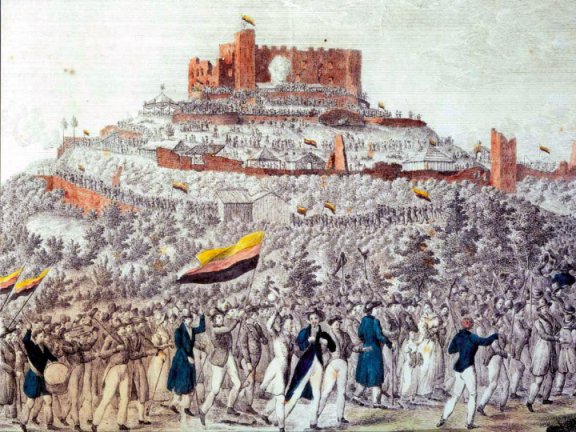
The Hambach Festival in 1832
The Wine Museum
This section of the museum offers an overview of the history of viticulture and wine consumption over more than 2,000 years.
Here, you’ll find the world’s oldest known grape wine, dating from around 325 AD.
![Speyer Wine Bottle © Carole Raddato - licence [CC BY-SA 2.0] from Wikimedia Commons Le plus vieux vin du monde à Spire en Allemagne © Carole Raddato - licence [CC BY-SA 2.0] from Wikimedia Commons](https://frenchmoments.eu/wp-content/uploads/2025/01/Speyer-Wine-Bottle-©-Carole-Raddato-licence-CC-BY-SA-2.0-from-Wikimedia-Commons-scaled-1.jpg)
The world’s oldest known grape wine in Speyer © Carole Raddato - licence [CC BY-SA 2.0] from Wikimedia Commons
![Speyer Wein Museum © DerHexer - licence [CC BY-SA 4.0] from Wikimedia Commons La partie du musée du Palatinat consacrée au vin © DerHexer - licence [CC BY-SA 4.0] from Wikimedia Commons](https://frenchmoments.eu/wp-content/uploads/2025/01/Speyer-Wein-Museum-©-DerHexer-licence-CC-BY-SA-4.0-from-Wikimedia-Commons-scaled-1.jpg)
The section of the museum dedicated to wine © DerHexer - licence [CC BY-SA 4.0] from Wikimedia Commons
Major Temporary Exhibitions
In addition, the museum hosts large annual temporary exhibitions: Richard the Lionheart, the Captive Knight (2017/2018), Marilyn Monroe, The Unknown (2018/2019), and Medicus, The Power of Knowledge (2019/2020).
Upon exiting the museum, walk about a hundred meters along *Domplatz and turn left onto Kleine Pfaffengasse. Then take another left onto Judengasse. Follow Judensbadgasse to the left.
The Jewish Bath
Our path takes us to an unusual spot in Old Speyer: the Jewish bath (Judenbad).
![Speyer Mikvah © Nemracc - licence [CC BY-SA 3.0] from Wikimedia Commons La Mikvah (bain juif) à Spire en Allemagne © Nemracc - licence [CC BY-SA 3.0] from Wikimedia Commons](https://frenchmoments.eu/wp-content/uploads/2025/01/Speyer-Mikvah-©-Nemracc-licence-CC-BY-SA-3.0-from-Wikimedia-Commons.jpg)
The Mikvah (jewisj bath) in Speyer, Germany © Nemracc - licence [CC BY-SA 3.0] from Wikimedia Commons
It is known that Jews lived on this site as early as the 1080s.
In 1100, a synagogue was built here to house the services of the Jewish community, one of the largest in the Holy Roman Empire.
The infrastructure of the ritual bath (mikveh) dates back to 1128, making it the oldest such monument in Germany.
![Judenbad Speyer © Chris 73 - licence [CC BY-SA 3.0] from Wikimedia Commons Le bain juif (Judenbad) à Spire en Allemagne © Chris 73 - licence [CC BY-SA 3.0] from Wikimedia Commons](https://frenchmoments.eu/wp-content/uploads/2025/01/Judenbad-Speyer-©-Chris-73-licence-CC-BY-SA-3.0-from-Wikimedia-Commons-scaled-1.jpg)
Judenbad in Speyer, Germany © Chris 73 - licence [CC BY-SA 3.0] from Wikimedia Commons
Along with Worms and Mainz, the diocese of Speyer was a major hub for Jews in the Holy Roman Empire.
The imperial privileges granted to these three cities did not prevent persecutions and pogroms.
The most severe occurred on January 22, 1349, when the Jewish community of Speyer was completely annihilated.
A new Jewish community settled there starting in 1354, only to be dissolved again in 1435.
Thus, the history of the Jewish community in Speyer was marked by cycles of persecution and periods of grace.
![Mikwe Speyer © Manuae - licence [CC BY-SA 4.0] from Wikimedia Commons Le bassin du Judenbad © Manuae - licence [CC BY-SA 4.0] from Wikimedia Commons](https://frenchmoments.eu/wp-content/uploads/2025/01/Mikwe-Speyer-©-Manuae-licence-CC-BY-SA-4.0-from-Wikimedia-Commons-scaled-1.jpg)
In the Judenbad © Manuae - licence [CC BY-SA 4.0] from Wikimedia Commons
The Holocaust
The Night of Kristallnacht, from November 9 to 10, 1938, was disastrous for the Jewish community of Speyer.
The synagogue, built in 1837, was destroyed.
During the Holocaust that followed, 81 Jewish residents of Speyer were deported, most of whom were murdered in concentration camps.
It is said that only one Jew survived the Nazi era by hiding in Speyer.
The Jewish community had completely disappeared from the city of Speyer until the 1990s.
A new synagogue was inaugurated on November 9, 2011, 73 years after the tragic Kristallnacht.
The SchPIRA Museum
In 2010, the city inaugurated the SchPIRA Museum, which showcases archaeological and historical collections focused on the three key pillars of the Jewish community: the synagogue, the cemetery, and the ritual bath. Schpira is the Hebrew name for the city of Speyer.
![Speyer Judenhof © Nemracc - licence [CC BY-SA 3.0] from Wikimedia Commons Cour des Juifs à Spire en Allemagne (Judenhof) © Nemracc - licence [CC BY-SA 3.0] from Wikimedia Commons](https://frenchmoments.eu/wp-content/uploads/2025/01/Speyer-Judenhof-©-Nemracc-licence-CC-BY-SA-3.0-from-Wikimedia-Commons.jpg)
The remains of the Jews' Court (Judenhof) © Nemracc - licence [CC BY-SA 3.0] from Wikimedia Commons
Follow Kleine Pfaffengasse, which leads to Königsplatz.
Königsplatz
Königsplatz literally means "the King's Square."
It dates back to 1806 and is lined with buildings that hold little architectural significance.
![Königsplatz © Manuae - licence [CC BY-SA 4.0] from Wikimedia Commons Spire en Allemagne - Königsplatz © Manuae - licence [CC BY-SA 4.0] from Wikimedia Commons](https://frenchmoments.eu/wp-content/uploads/2025/01/Speyer-Konigsplatz-©-Manuae-licence-CC-BY-SA-4.0-from-Wikimedia-Commons.jpg)
The fountain at the centre of the Königsplatz © Manuae - licence [CC BY-SA 4.0] from Wikimedia Commons
That said, take a moment to observe the Pretzel Fountain in the centre of the square.
Dating back to 1953, it features a boy holding Speyer’s pretzels and the coat of arms of the 16 guilds.
It’s also worth noting that this square was once the site of a large Roman column dedicated to Jupiter, which is now displayed at the Historical Museum of the Palatinate.
This would indicate the presence of a Roman forum at the location.
The square comes alive on market days (every Saturday, from 7 AM to 1 PM).
It’s where my mother would buy fresh seasonal fruits and vegetables when we lived in Speyer, including the famous Palatinate asparagus!
I recommend heading to the Altpörtel via Ludwigstraße and Roßmarktstraße... and if you have time, make a small detour to Feuerbachhaus (turn left onto Allerheiligenstraße).
Feuerbach's House
In 1971, the birthplace of the painter was saved from demolition by an association created specifically for this purpose.
Today, the Feuerbachhaus houses a museum dedicated to the painter, a memorial, and a wine bar.
![Speyer Feuerbachhaus © Sundar1 - licence [CC BY-SA 3.0] from Wikimedia Commons Spire en Allemagne - Feuerbachhaus © Sundar1 - licence [CC BY-SA 3.0] from Wikimedia Commons](https://frenchmoments.eu/wp-content/uploads/2025/01/Speyer-Feuerbachhaus-©-Sundar1-licence-CC-BY-SA-3.0-from-Wikimedia-Commons-scaled-1.jpg)
The native home of painter Feuerbach © Sundar1 - licence [CC BY-SA 3.0] from Wikimedia Commons
This cultural centre in Speyer displays around thirty paintings by Anselm Feuerbach, primarily portraits and self-portraits.
Delicate watercolours of flowers by his older sister Emilie, excerpts from Anselm’s letters, and information about the family complement the exhibition.
Who was Anselm Feuerbach?
The painter Anselm Feuerbach (Speyer, 12 September 1829 – Venice, 4 January 1880) came from a renowned German family.
The young artist studied at the Düsseldorf Academy of Fine Arts before traveling to Munich, Antwerp, and Paris.
Thanks to a scholarship from the Grand Duke of Baden, Anselm Feuerbach went to Italy, where he would spend 17 years of his life.
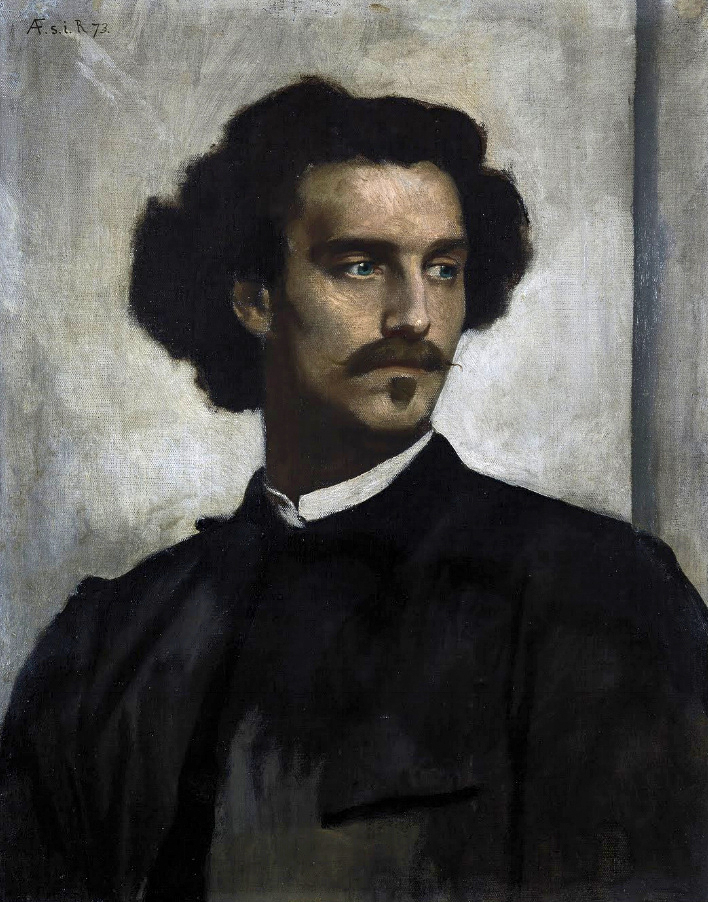
Portrait of Anselm Feuerbach in 1873
Anselm Feuerbach declared in 1876 :
"To be a good painter, one needs four things: a gentle heart, a sharp eye, a light hand, and brushes always freshly cleaned."
![Feuerbachhaus Garten © Manuae - licence [CC BY-SA 4.0] from Wikimedia Commons Feuerbachhaus Garten © Manuae - licence [CC BY-SA 4.0] from Wikimedia Commons](https://frenchmoments.eu/wp-content/uploads/2025/01/Feuerbachhaus-Garten-©-Manuae-licence-CC-BY-SA-4.0-from-Wikimedia-Commons.jpg)
The garden of Feuerbach's House © Manuae - licence [CC BY-SA 4.0] from Wikimedia Commons
Head to Postplatz via Roßmarktstraße. You’ll enjoy a picturesque side view of the Altpörtel.
![Rossmarktstrasse and Altpoertel Speyer © Gerd Eichmann - licence [CC BY-SA 4.0] from Wikimedia Commons Spire en Allemagne - L'Altpörtel et la Rossmarktstrasse © Gerd Eichmann - licence [CC BY-SA 4.0] from Wikimedia Commons](https://frenchmoments.eu/wp-content/uploads/2025/01/Rossmarktstrasse-and-Altpoertel-Speyer-©-Gerd-Eichmann-licence-CC-BY-SA-4.0-from-Wikimedia-Commons-scaled-1.jpg)
The Altpörtel seen from Rossmarktstrasse © Gerd Eichmann - licence [CC BY-SA 4.0] from Wikimedia Commons
Route 3 - North of Maximilianstraße
- Length : Approximately 1,5 km
- Starting Point : Postplatz
- Ending Point : Domplatz
This district of Speyer once housed many churches and monasteries that were dissolved and nationalized following the French Revolution.
Often, the sanctuaries and their complexes were sold off to be demolished.
Only the Guidostift, the Dominican monastery (St. Ludwig), the convent of St. Mary Magdalene, Ägidienkirche, and the cathedral survived the destruction and have been preserved to this day.
Along Korngasse
On the city side of the Altpörtel, follow the Korngasse alley all the way to its junction with Maximilianstraße.
The residents of Speyer appreciate Korngasse (the Wheat Alley) for its rustic cafés and wine taverns, as well as its craft shops.
You’ll find a shopping gallery (Kornmarkt), jewellery workshops, and fashion boutiques along the street.
![Korngasse Speyer © Manuae - licence [CC BY-SA 3.0] from Wikimedia Commons Spire en Allemagne - Korngasse © Manuae - licence [CC BY-SA 3.0] from Wikimedia Commons](https://frenchmoments.eu/wp-content/uploads/2025/01/Korngasse-Speyer-©-Manuae-licence-CC-BY-SA-3.0-from-Wikimedia-Commons-scaled-1.jpg)
The Korngasse © Manuae - licence [CC BY-SA 3.0] from Wikimedia Commons
At the Alte Münze, turn left onto Salzgasse (Salt Alley).
Heiliggeistkirche
At the next crossroads, look to your left (on Johannesstraße) to see the Church of the Holy Spirit (Heiliggeistkirche).
This hall church in Baroque style was built between 1700 and 1702 to house the place of worship for the Reformed community of Speyer.
In 1792, during the French Revolution, this church became the meeting place for the Jacobins of Speyer.
It wasn’t until ten years later, under Napoleon, that the Protestant congregation regained access to their church.
![Speyer Heiliggeistkirche © Leiflive - licence [CC BY-SA 4.0] from Wikimedia Commons Spire en Allemagne - Heiliggeistkirche © Leiflive - licence [CC BY-SA 4.0] from Wikimedia Commons](https://frenchmoments.eu/wp-content/uploads/2025/01/Speyer-Heiliggeistkirche-©-Leiflive-licence-CC-BY-SA-4.0-from-Wikimedia-Commons-scaled-1.jpg)
The Heiliggeistkirche © Leiflive - licence [CC BY-SA 4.0] from Wikimedia Commons
Laufturm
A glance to the right (on Große Himmelsgasse) and you can’t miss the white bell tower of the Laufturm.
It marks the location of the former St. George’s Church and its hospice, founded in 1260.
In 1555, the church and hospital became Protestant but were destroyed during the great fire of Speyer in 1689, set by the troops of Louis XIV.
![Speyer Laufturm © AnRo0002 - licence [CC0] from Wikimedia Commons Spire en Allemagne - Laufturm © AnRo0002 - licence [CC0] from Wikimedia Commons](https://frenchmoments.eu/wp-content/uploads/2025/01/Speyer-Laufturm-©-AnRo0002-licence-CC0-from-Wikimedia-Commons.jpg)
The bell tower of the Laufturm © AnRo0002 - licence [CC0] from Wikimedia Commons
The complex was rebuilt after the war.
The tower itself underwent a major restoration in 1822, which included the installation of a carillon and a clock.
On July 2, 1891, another fire destroyed the church, which was not rebuilt.
The bell tower and its beautiful Neo-Baroque lantern are therefore the only remaining witnesses of the former St. George’s Church and its hospice.
Fischmarkt
Head down St. Georgen-Gasse to the Fischmarkt (Fish Market).
![Spire en Allemagne - La fontaine de la Fischmarkt © Sundar1 - licence [CC BY-SA 3.0] from Wikimedia Commons Spire en Allemagne - La fontaine de la Fischmarkt © Sundar1 - licence [CC BY-SA 3.0] from Wikimedia Commons](https://frenchmoments.eu/wp-content/uploads/2025/01/Speyer-Fischmarktbrunnen-©-Sundar1-licence-CC-BY-SA-3.0-from-Wikimedia-Commons-scaled-1.jpg)
The fountain of the Fischmarkt © Sundar1 - licence [CC BY-SA 3.0] from Wikimedia Commons
The Fischmarkt (Fish Market), mentioned as forum piscium as early as 1290, once stretched along the Speyerbach River.
The area has undergone significant changes since the Middle Ages, and the square was redeveloped in 1982 with the addition of a fish-shaped fountain on stilts.
This sculpture was created by the Landau-born artist Stefan Forler.
It serves as a reminder of the centuries-old fishing trade, which has since disappeared from Speyer.
The Kutscherhaus (Coachman’s House), bordering the square, is a timber-framed building dating from 1901 (so it’s not medieval, despite its appearance!).
![Fischmarkt Speyer © Manuae - licence [CC BY-SA 4.0] from Wikimedia Commons Speyer, Germany - La Kutscherhaus sur la Fischmarkt © Manuae - licence [CC BY-SA 4.0] from Wikimedia Commons](https://frenchmoments.eu/wp-content/uploads/2025/01/Fischmarkt-Speyer-©-Manuae-licence-CC-BY-SA-4.0-from-Wikimedia-Commons-scaled-1.jpg)
Kutscherhaus on Fischmarkt © Manuae - licence [CC BY-SA 4.0] from Wikimedia Commons
It was in this square that the children of my primary school class sang "Frère Jacques" in German during a Franco-German event gathering primary schools from Speyer.
![Fischmarkt and Kutscherhaus © Franzfoto - licence [CC BY-SA 3.0] from Wikimedia Commons Speyer, Germany - Fischmarkt and Kutscherhaus © Franzfoto - licence [CC BY-SA 3.0] from Wikimedia Commons](https://frenchmoments.eu/wp-content/uploads/2025/01/Fischmarkt-and-Kutscherhaus-©-Franzfoto-licence-CC-BY-SA-3.0-from-Wikimedia-Commons-scaled-1.jpg)
The Kutscherhaus on Fischmarkt and Speyer Cathedral in the distance © Franzfoto - licence [CC BY-SA 3.0] from Wikimedia Commons
The Narrow Streets of Holzmarkt
Walk towards Holzmarkt and wander through the picturesque little alleys on the right.
Take St.-Veltengasse to reach the ruins of the Retscher.
![Retscherhof © Franzfoto - licence [CC BY-SA 3.0] from Wikimedia Commons Speyer, Germany - St-Veltengasse © Franzfoto - licence [CC BY-SA 3.0] from Wikimedia Commons](https://frenchmoments.eu/wp-content/uploads/2025/01/Retscherhof-©-Franzfoto-licence-CC-BY-SA-3.0-from-Wikimedia-Commons-scaled-1.jpg)
St-Veltengasse © Franzfoto - licence [CC BY-SA 3.0] from Wikimedia Commons
The Ruins of the Retscher
These ruins belong to a Gothic mansion, the Retscher.
Today, it is located adjacent to the rear of the Church of the Holy Trinity.
Local tradition (though incorrect) claimed it to be the site of the 1529 Imperial Diet, during which the famous Protestation of Speyer took place.
The great fire of Speyer in 1689 left it in ruins.
However, it remains the only significant medieval secular building in the city whose remains are still substantial.
![Retscher © Willie 2000 - licence [CC BY-SA 4.0] from Wikimedia Commons Speyer, Germany - Retscher à Spire en Allemagne © Willie 2000 - licence [CC BY-SA 4.0] from Wikimedia Commons](https://frenchmoments.eu/wp-content/uploads/2025/01/Retscher-©-Willie-2000-licence-CC-BY-SA-4.0-from-Wikimedia-Commons-scaled-1.jpg)
The ruins of the Retscher © Willie 2000 - licence [CC BY-SA 4.0] from Wikimedia Commons
This former patrician house dates back to 1241 and is named after its first resident, Retschelinus (mentioned in 1241).
Return to Holzmarkt via St.-Margarethengasse.
Turn left onto Mittelsteg to cross the Speyererbach river.
Take a right onto Hasenpfuhlstraße until you reach the crossroads with Sonnengasse.
Hasenpfuhl
This is the Hasenpfuhl district (literally "hare's paw"), which was first mentioned in writing in 1232. After the War of the Palatinate Succession, the suburb became the neighbourhood of fishermen and boatmen.
![Speyer Hasenpfuhl © Sundar1 - licence [CC BY-SA 3.0] from Wikimedia Commons Speyer, Germany - Le quartier du Hasenpfuhl de Spire en Allemagne © Sundar1 - licence [CC BY-SA 3.0] from Wikimedia Commons](https://frenchmoments.eu/wp-content/uploads/2025/01/Speyer-Hasenpfuhl-©-Sundar1-licence-CC-BY-SA-3.0-from-Wikimedia-Commons-scaled-1.jpg)
The Hasenpfuhl district near the Sonnebrücke. © Sundar1 - licence [CC BY-SA 3.0] from Wikimedia Commons
Klosterkirche St. Magdalena
At the crossroads, observe the Church of the Convent of St. Mary Magdalene, dating from 1717.
![Speyer St. Magdalena © Dickelbers - licence [CC BY-SA 3.0] from Wikimedia Commons Speyer, Germany - St. Magdalena © Dickelbers - licence [CC BY-SA 3.0] from Wikimedia Commons](https://frenchmoments.eu/wp-content/uploads/2025/01/Speyer-St.-Magdalena-©-Dickelbers-licence-CC-BY-SA-3.0-from-Wikimedia-Commons-scaled-1.jpeg)
The entrance to the convent © Dickelbers - licence [CC BY-SA 3.0] from Wikimedia Commons
Of the around sixty monasteries in the Palatinate, the Convent of St. Mary Magdalene is the only one to have endured through the centuries and their upheavals.
The nuns have lived and worked there for nearly 800 years..
![Speyer St. Magdalena © AnRo0002 - licence [CC0] from Wikimedia Commons Speyer, Germany - L'église du couvent St. Magdalena © AnRo0002 - licence [CC0] from Wikimedia Commons](https://frenchmoments.eu/wp-content/uploads/2025/01/Speyer-St.-Magdalena-©-AnRo0002-licence-CC0-from-Wikimedia-Commons.jpg)
The church of the convent St. Magdalena © AnRo0002 - licence [CC0] from Wikimedia Commons
Take Sonnengasse.
Sonnenbrücke
The Sonnenbrücke (Sun Bridge) is one of the most photogenic spots in Speyer, with the cathedral stretching out in its full length in the background.
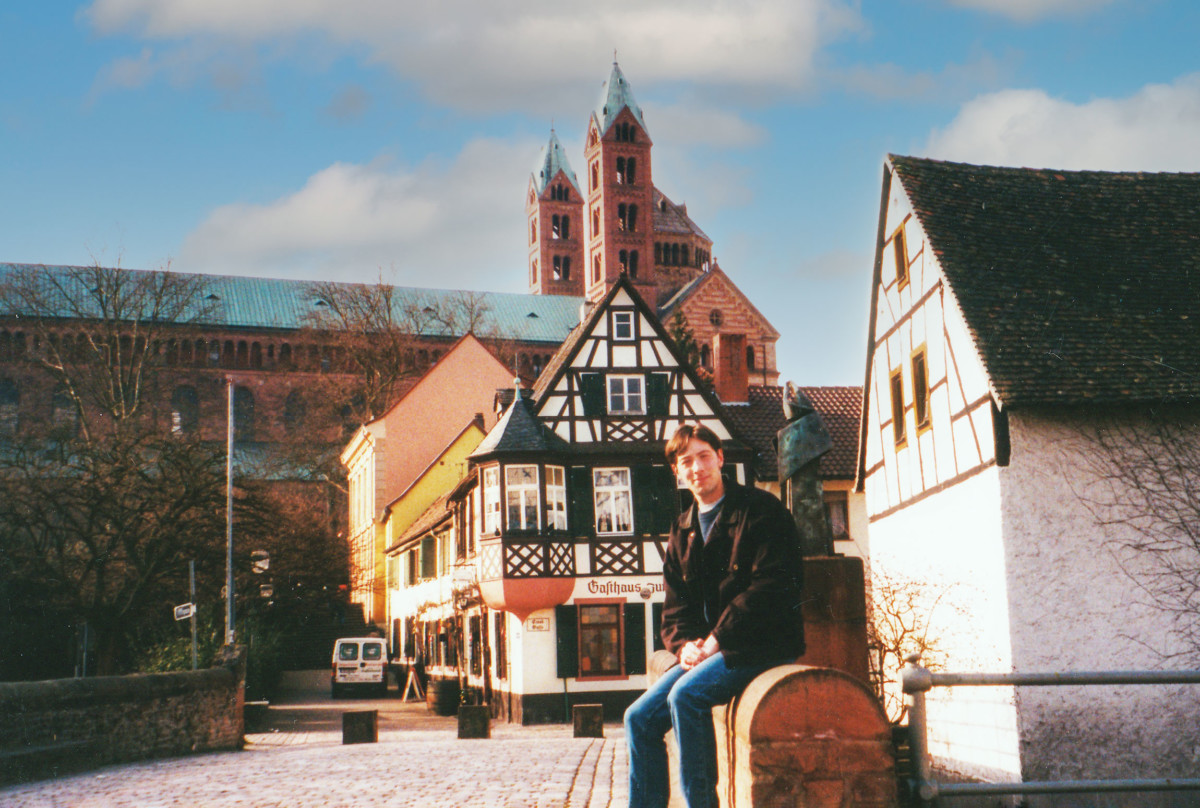
Me on the Sonnenbrücke in Speyer, Germany © Pierre Guernier
The Sonnenbrücke is the only medieval bridge in Speyer that has been preserved almost in its original state.
It was first mentioned around 1242 under its original name, the Nikolausbrücke (St. Nicholas Bridge).
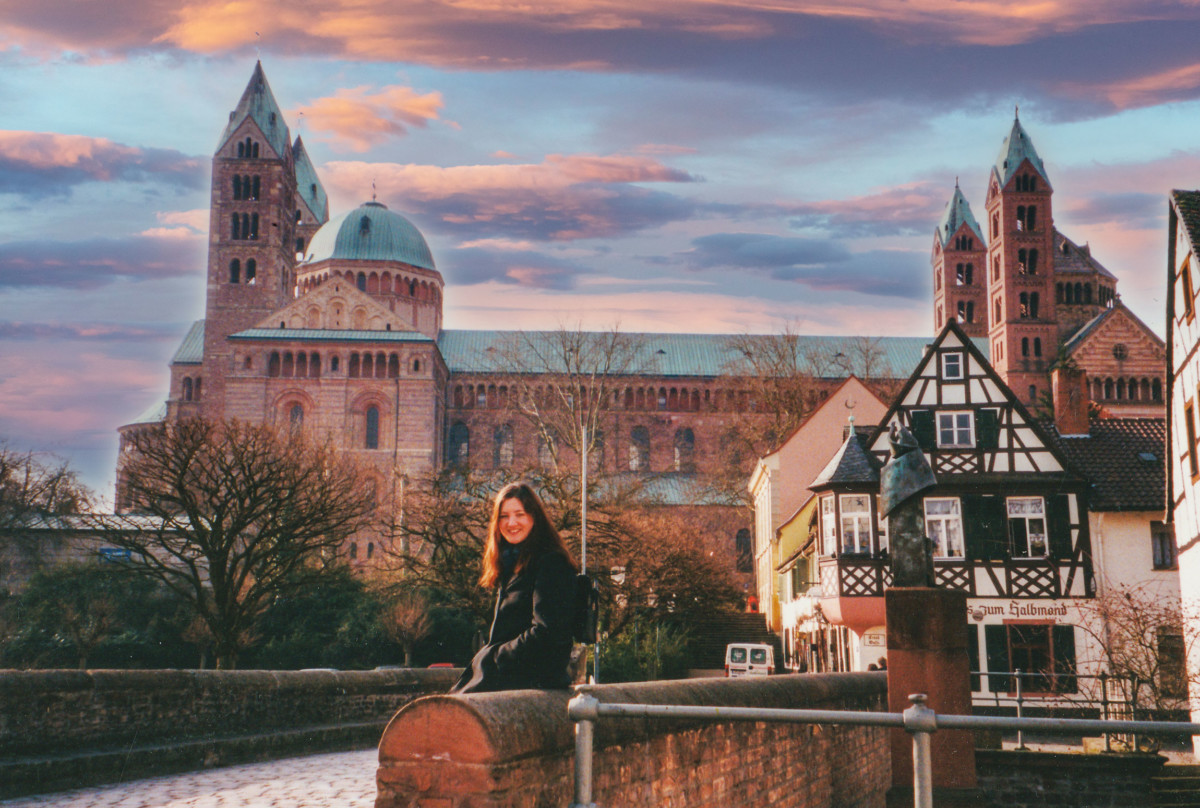
My wife Rachel on the Sonnenbrücke © Pierre Guernier
Half-timbered Houses
The timber-framed house is the former inn *Zur Sonne* (To the Sun), which gave its name to both the Sonnenbrücke bridge and the street of the same name.
![Speyer Sonnengasse © AnRo0002 - licence [CC0] from Wikimedia Commons Speyer, Germany - Sonnengasse à Spire en Allemagne© AnRo0002 - licence [CC0] from Wikimedia Commons](https://frenchmoments.eu/wp-content/uploads/2025/01/Speyer-Sonnengasse-©-AnRo0002-licence-CC0-from-Wikimedia-Commons.jpg)
One of the half-timbered houses on Sonnengasse © AnRo0002 - licence [CC0] from Wikimedia Commons
The half-timbered houses on both sides of the bridge were destroyed in 1689 during the War of the Palatinate Succession and were rebuilt between 1698 and 1702.
The great fire caused by the French in 1689 explains the relative absence of half-timbered houses in the old town.
However, there are some exceptions, including those we saw on either side of the Sonnenbrücke.
You can also find a few examples along the alleys leading towards the cathedral square: Tränkgasse and Stuhlbrudergasse.
![Speyer Pistoreigasse © AnRo0002 - licence [CC0] from Wikimedia Commons Speyer, Germany - Maison à colombages au carrefour des Stuhlbrudergasse et Pistoreigasse © AnRo0002 - licence [CC0] from Wikimedia Commons](https://frenchmoments.eu/wp-content/uploads/2025/01/Speyer-Pistoreigasse-©-AnRo0002-licence-CC0-from-Wikimedia-Commons-scaled-1.jpg)
Half-timbered house at the crossroads of Stuhlbrudergasse and Pistoreigasse. © AnRo0002 - licence [CC0] from Wikimedia Commons
![Tränkgasse 2 Speyer © Tilman2007 - licence [CC BY-SA 4.0] from Wikimedia Commons Speyer, Germany - Nº2 Tränkgasse © Tilman2007 - licence [CC BY-SA 4.0] from Wikimedia Commons](https://frenchmoments.eu/wp-content/uploads/2025/01/Trankgasse-2-Speyer-©-Tilman2007-licence-CC-BY-SA-4.0-from-Wikimedia-Commons-scaled-1.jpg)
Nº2 Tränkgasse © Tilman2007 - licence [CC BY-SA 4.0] from Wikimedia Commons
Sites Off the Beaten Path in Speyer, Germany
If you’re curious and want to explore every corner of Speyer, Germany, here are a few recommendations for sites and monuments to visit:
The Cloister of the Augustinian Monastery
Hagerdornsgasse
As its name suggests, Augustinergasse evokes the memory of the Augustinian Monastery in Speyer, which was destroyed in 1866.
Founded in the mid-13th century and rebuilt between 1697 and 1714, the monastery’s only surviving remnant is this 15th-century Gothic cloister, which was reconstructed here in 1986.
![Augustine Cloister Speyer LR © Sundar1 - licence [CC BY-SA 4.0] from Wikimedia Commons Speyer, Germany - Augustine Cloister Speyer LR © Sundar1 - licence [CC BY-SA 4.0] from Wikimedia Commons](https://frenchmoments.eu/wp-content/uploads/2025/01/Augustine-Cloister-Speyer-LR-©-Sundar1-licence-CC-BY-SA-4.0-from-Wikimedia-Commons-scaled-1.jpg)
The Augustinian Cloister © Sundar1 - licence [CC BY-SA 4.0] from Wikimedia Commons
Friedenskirche St. Bernhard
3 Hirschgraben
On Christmas Day, 1146, the famous Burgundian monk Bernard of Clairvaux preached the Second Crusade at the Speyer Cathedral.
In 1952, the chapter of the Speyer Cathedral proposed the construction of a church as part of the commemoration of the 800th anniversary of the saint's death.
The church was built to the north of the old town between 1953 and 1954.
Its inauguration brought together French and German bishops (from Metz, Strasbourg, Mainz, and Speyer), Chancellor Konrad Adenauer, and French Foreign Minister Robert Schuman.
Indeed, the new church was intended to serve as a symbol of reconciliation between Germany and France.
Half of the construction costs were funded through collections from French Catholics. Hence its name: Friedenskirche St. Bernhard (St. Bernard Peace Church).
The architecture is characterised by very simple yet harmonious forms, echoing the Cistercian monasteries of the Middle Ages.
![Saint-Bernard Speyer © BlueBreezeWiki - licence [CC BY-SA 3.0] from Wikimedia Commons Speyer, Germany - L'église Saint-Bernard de Spire en Allemagne © BlueBreezeWiki - licence [CC BY-SA 3.0] from Wikimedia Commons](https://frenchmoments.eu/wp-content/uploads/2025/01/Saint-Bernard-Speyer-©-BlueBreezeWiki-licence-CC-BY-SA-3.0-from-Wikimedia-Commons-scaled-1.jpg)
L'église Saint-Bernard de Spire en Allemagne © BlueBreezeWiki - licence [CC BY-SA 3.0] from Wikimedia Commons
Hirschgraben and Speyer's Oldest Building
The Hirschgraben was a defensive moat of the city fortifications of Speyer.
The city walls have now given way to an avenue: Hirschgraben.
On the southern side of the street stands the oldest house in Speyer.
In fact, it is part of the former medieval city wall, within which a dwelling was constructed.
This house was part of the Saint Guido Abbey complex.
The stone façade dates back to the 1100s.
You can still see the Romanesque crenellations and a crossbow slit.
![Hirschgraben Speyer © Manuae - licence [CC BY-SA 3.0] from Wikimedia Commons Speyer, Germany - La maison du Hirschgraben © Manuae - licence [CC BY-SA 3.0] from Wikimedia Commons](https://frenchmoments.eu/wp-content/uploads/2025/01/Hirschgraben-Speyer-©-Manuae-licence-CC-BY-SA-3.0-from-Wikimedia-Commons-scaled-1.jpg)
La maison du Hirschgraben © Manuae - licence [CC BY-SA 3.0] from Wikimedia Commons
Adenauer Park
Adenauer Park is a peaceful haven to the north of Speyer.
The green space features a lily pond created in 1858 and several old trees, including a sequoia, an English oak, a Japanese maple, and a Himalayan birch.
The park occupies the site of the former Speyer cemetery, which explains the presence of many funeral stelae.
It is also the final resting place of former German Chancellor Helmut Kohl (1930-2017).
![Helmut Kohl Tomb © Smalltown Boy - licence [CC0] from Wikimedia Commons Speyer, Germany - La tombe du chancelier Helmut Kohl à Spire en Allemagne © Smalltown Boy - licence [CC0] from Wikimedia Commons](https://frenchmoments.eu/wp-content/uploads/2025/01/Helmut-Kohl-Tomb-©-Smalltown-Boy-licence-CC0-from-Wikimedia-Commons-scaled-1.jpg)
The tomb of Chancellor Helmut Kohl © Smalltown Boy - licence [CC0] from Wikimedia Commons
The Gothic chapel dates back to 1516.
In 1520, a sandstone Mount of Olives was added to complete the sanctuary.
Miraculously, Louis XIV’s troops spared it during the War of the Palatinate Succession.
It also survived the French Revolution without any issues!
![Speyer © BlueBreezeWiki - licence [CC BY-SA 3.0] from Wikimedia Commons Speyer, Germany - La chapelle du parc Adenauer à Spire en Allemagne © BlueBreezeWiki - licence [CC BY-SA 3.0] from Wikimedia Commons](https://frenchmoments.eu/wp-content/uploads/2025/01/Speyer-©-BlueBreezeWiki-licence-CC-BY-SA-3.0-from-Wikimedia-Commons-scaled-1.jpg)
Chapel of the Adenauer Park © BlueBreezeWiki - licence [CC BY-SA 3.0] from Wikimedia Commons
Riegel
Riegel is the name of an arch bridge over the Speyererbach river.
It is a remnant of Speyer’s medieval city walls.
A private garden at the end of Mehlgasse provides access to the bridge, but it is only open during group tours and public visits during the Grynen Band event.
During my years in Speyer, we had a lovely view of the Riegel from the Mörschgasse bridge, with the cathedral in the background.
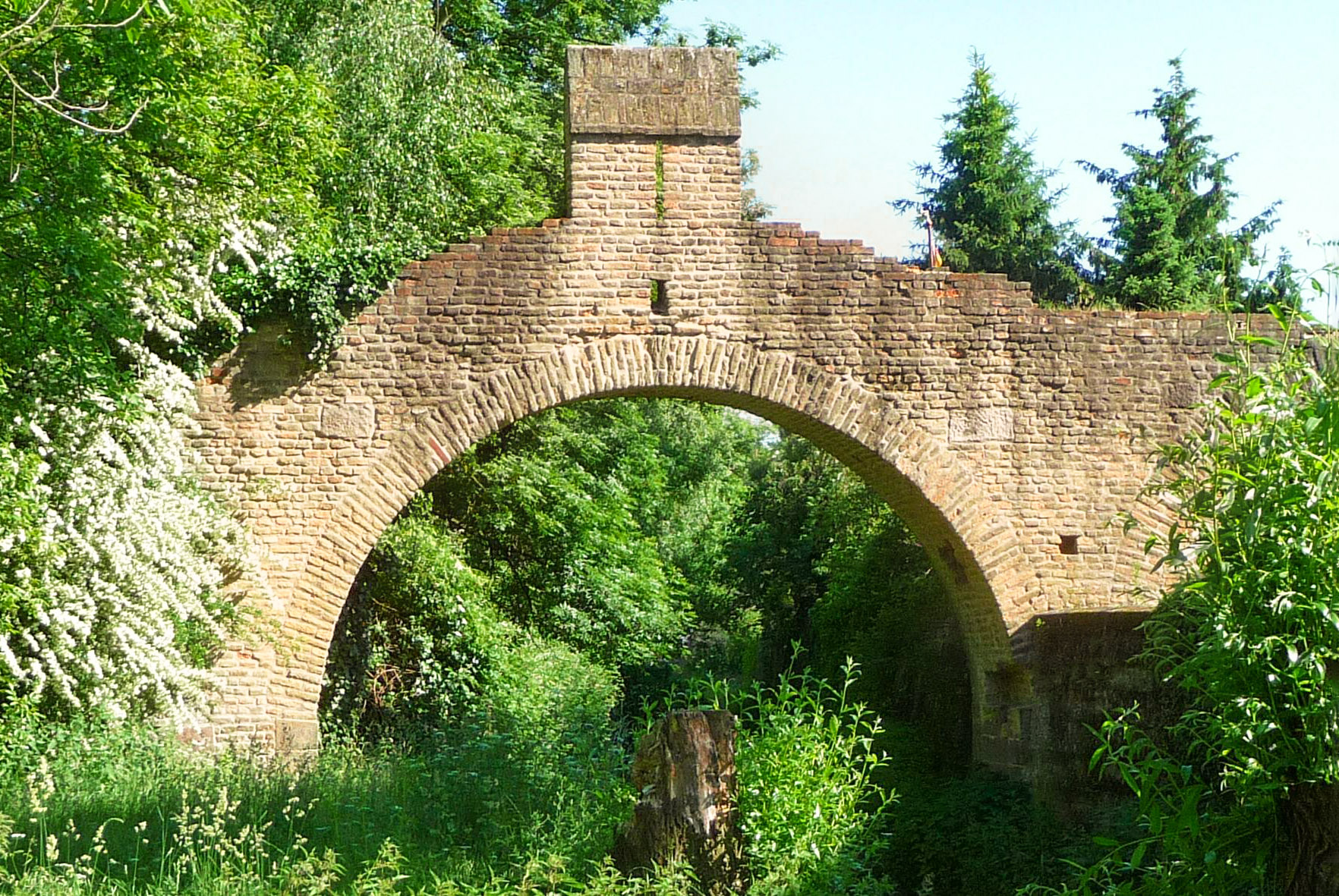
The fortified archway of the Riegel in Speyer, Germany. Photo by Immanuel Giel (Domaine Public)
Purrmann-Haus
14 Kleine Greifengasse
The museum of Speyer-born painter Hans Purrmann (1880–1966) showcases objects that document and illustrate the lives of Hans Purrmann and Mathilde Vollmoeller-Purrmann (paintings, prints, watercolours, sculptures, and more).
Technik-Museum Speyer
One of the main attractions in Speyer, the Technical Museum, displays a vast number of technologies related to vehicle and aircraft construction across a covered area of 25,000 m² and an outdoor space of 100,000 m².
![Speyer Technik Museum © Rolf Kickuth - licence [CC BY-SA 4.0] from Wikimedia Commons Vue d'ensemble du musée technique de Spire © Rolf Kickuth - licence [CC BY-SA 4.0] from Wikimedia Commons](https://frenchmoments.eu/wp-content/uploads/2025/01/Speyer-Technik-Museum-©-Rolf-Kickuth-licence-CC-BY-SA-4.0-from-Wikimedia-Commons-scaled-1.jpg)
General view of the Technical Museum © Rolf Kickuth - licence [CC BY-SA 4.0] from Wikimedia Commons
The museum houses the largest propeller-driven aircraft in the world (the Antonov An-22), the German Navy’s U9 submarine, the Russian Bourane orbiter, a Lufthansa Boeing 747-200, steam locomotives, a helicopter, racing motorcycles, fire trucks, and more.
![Tecknik Museum Speyer © Triple-vert - licence [CC BY-SA 2.0] from Wikimedia Commons Speyer, Germany - Tecknik Museum à Spire en Allemagne © Triple-vert - licence [CC BY-SA 2.0] from Wikimedia Commons](https://frenchmoments.eu/wp-content/uploads/2025/01/Tecknik-Museum-Speyer-©-Triple-vert-licence-CC-BY-SA-2.0-from-Wikimedia-Commons-scaled-1.jpg)
Tecknik Museum in Speyer, Germany © Triple-vert - licence [CC BY-SA 2.0] from Wikimedia Commons
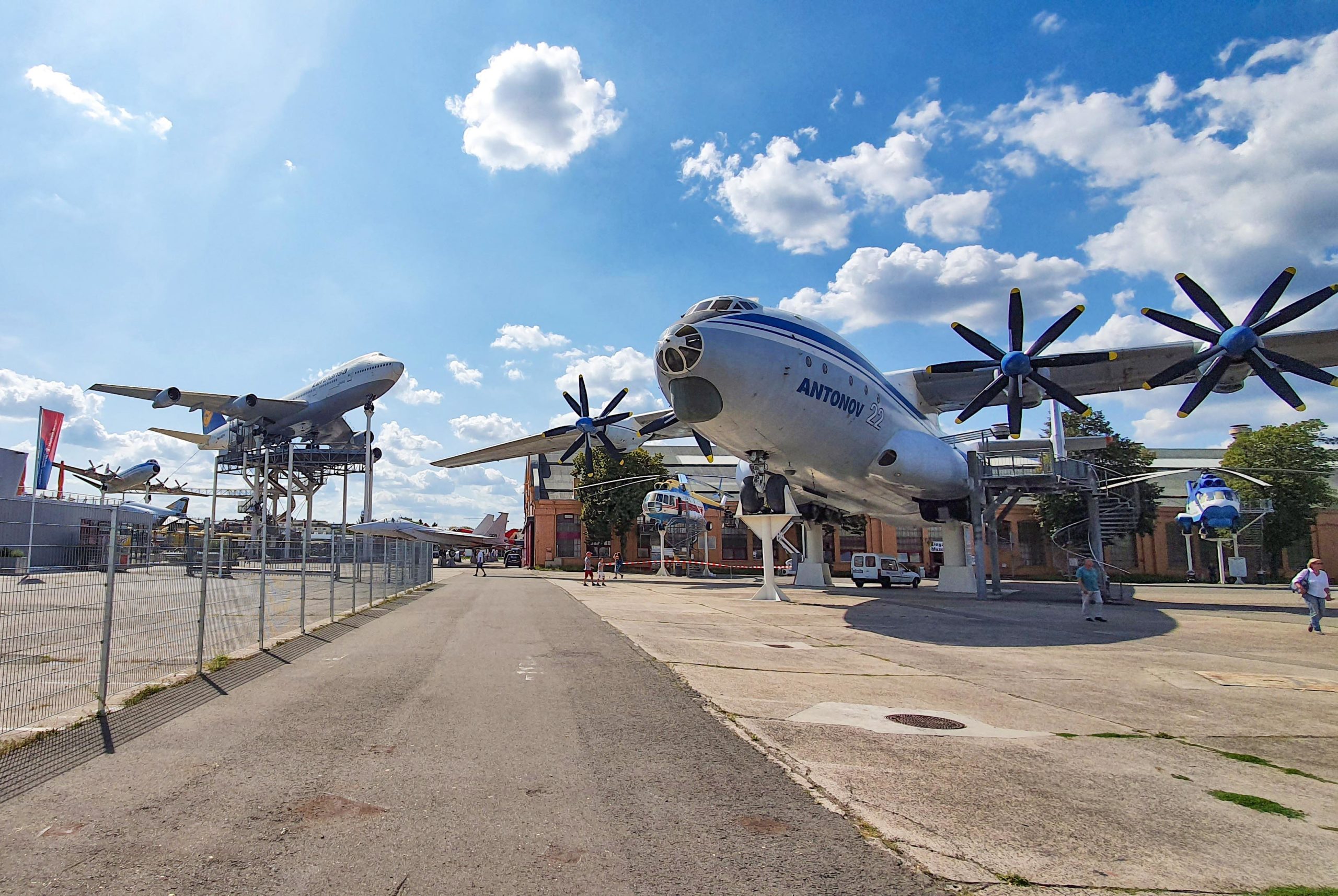
At the Technik Museum in Speyer, Germany. Photo @Serfercar via Twenty20
![Tecknik Museum à Spire en Allemagne © Triple-vert - licence [CC BY-SA 2.0] from Wikimedia Commons Speyer, Germany - Tecknik Museum à Spire en Allemagne © Triple-vert - licence [CC BY-SA 2.0] from Wikimedia Commons](https://frenchmoments.eu/wp-content/uploads/2025/01/Tecknik-Museum-Speyer-2-©-Triple-vert-licence-CC-BY-SA-2.0-from-Wikimedia-Commons-scaled-1.jpg)
Tecknik Museum in Speyer, Germany © Triple-vert - licence [CC BY-SA 2.0] from Wikimedia Commons
The Technical Museum extends over the grounds of the Martin Barracks (Caserne Martin), previously occupied by an FFA regiment (French Forces stationed in Germany).
The French history of the site is reflected in the name of the main building housing the collections: Liller Halle (the Lille Hall).
Fastnachtsmuseum
Wormser Landstraße
Curiously, the Warturm stands in the midst of a commercial and industrial area to the north of Speyer.
The four floors of this former medieval watchtower now house the Carnival Museum.
The museum documents the unique tradition of carnivals in the Upper Rhine region (such as the one in Mulhouse).
It features documents and photographs on the history of carnival, song lyrics, fool’s hats, costumes (including that of Count Kuno of Bruchsal, the famous hunter of Kurpfalz, and the witch Hottschreck from the Grötzingen fools' guild).
![Warturm © Claus Ableiter - licence [CC BY-SA 3.0] from Wikimedia Commons Speyer, Germany - La Warturm abrite le musée du carnaval © Claus Ableiter - licence [CC BY-SA 3.0] from Wikimedia Commons](https://frenchmoments.eu/wp-content/uploads/2025/01/Warturm-©-Claus-Ableiter-licence-CC-BY-SA-3.0-from-Wikimedia-Commons-scaled-1.jpg)
The Warturm houses the Carnival Museum © Claus Ableiter - licence [CC BY-SA 3.0] from Wikimedia Commons
More about Speyer, Germany
- My detailed article on the Imperial Cathedral of Speyer
- My article on the Gedächtniskirche of Speyer, the memorial church of the Protestation
- The French connexion de l'Altpörtel or how Speyer’s old gate nearly vanished under French occupation
- The official website of the City of Speyer, Germany
- The Wikipedia Page on Speyer, Germany
- A list of accommodations to organise your stay in Speyer
- Find the most beautiful photos of Speyer on Instagram from the profiles: VisitSpeyer and ILoveSpeyer. Perfect for getting a sense of Speyer’s heritage!
Speyer, Germany: Pin it on Pinterest
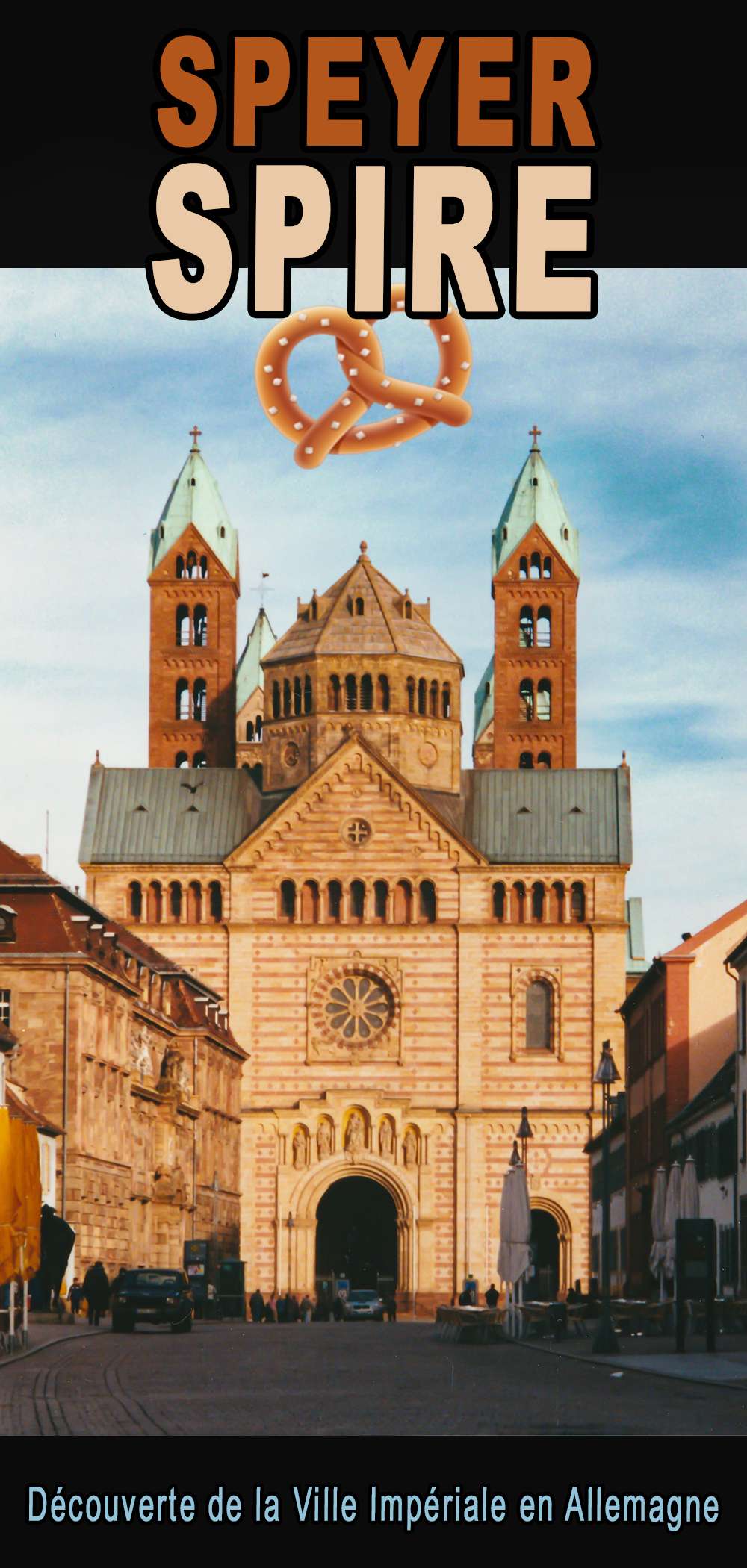
Featured image: the cathedral of Speyer, Germany seen from the Altpörtel © Roman Eisele - licence [CC BY-SA 4.0] from Wikimedia Commons.

![Speyer Germany © Roman Eisele - licence [CC BY-SA 4.0] from Wikimedia Commons](https://frenchmoments.eu/wp-content/uploads/2025/01/Speyer-Germany-©-Roman-Eisele-licence-CC-BY-SA-4.0-from-Wikimedia-Commons.jpg)

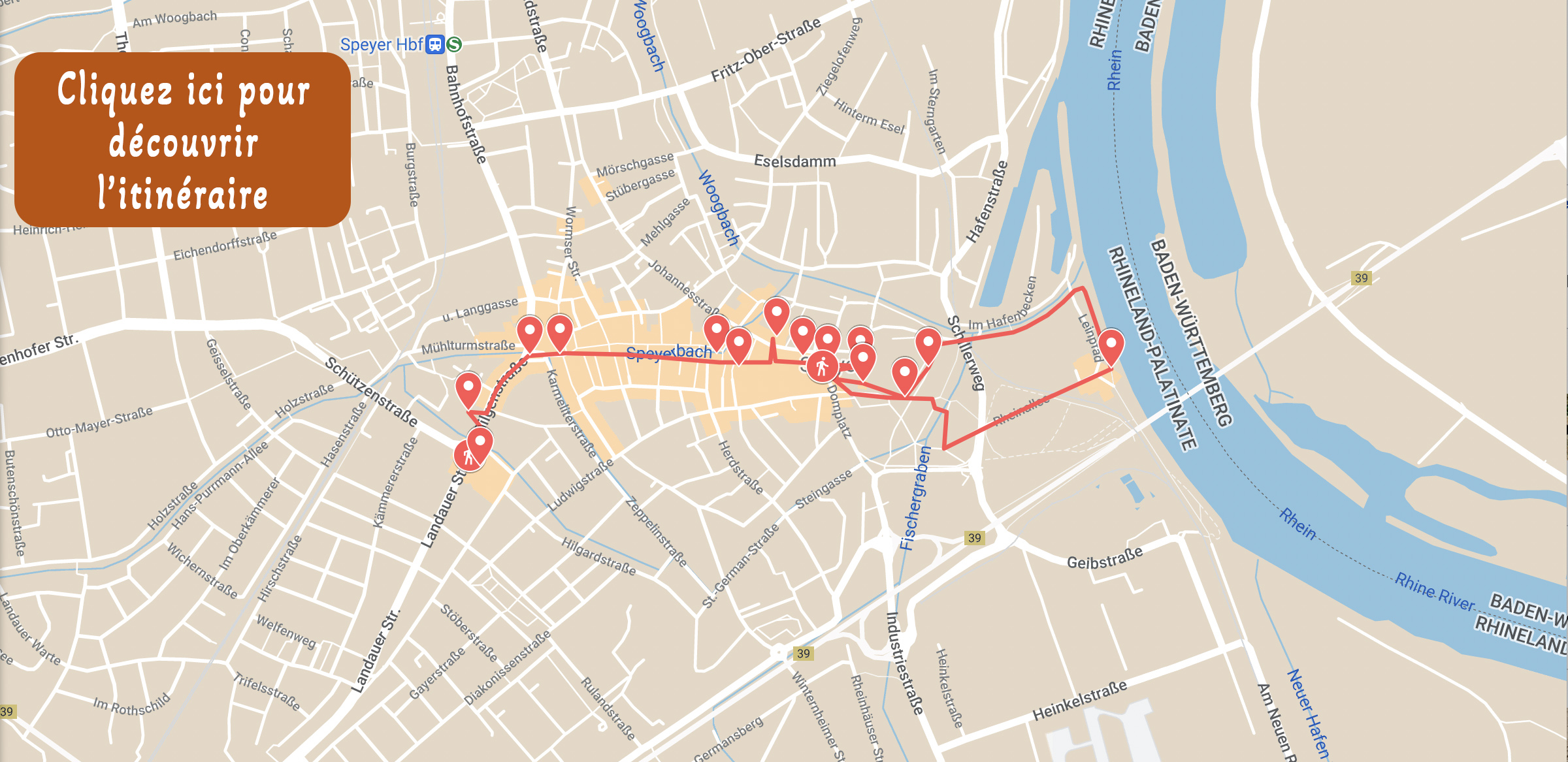
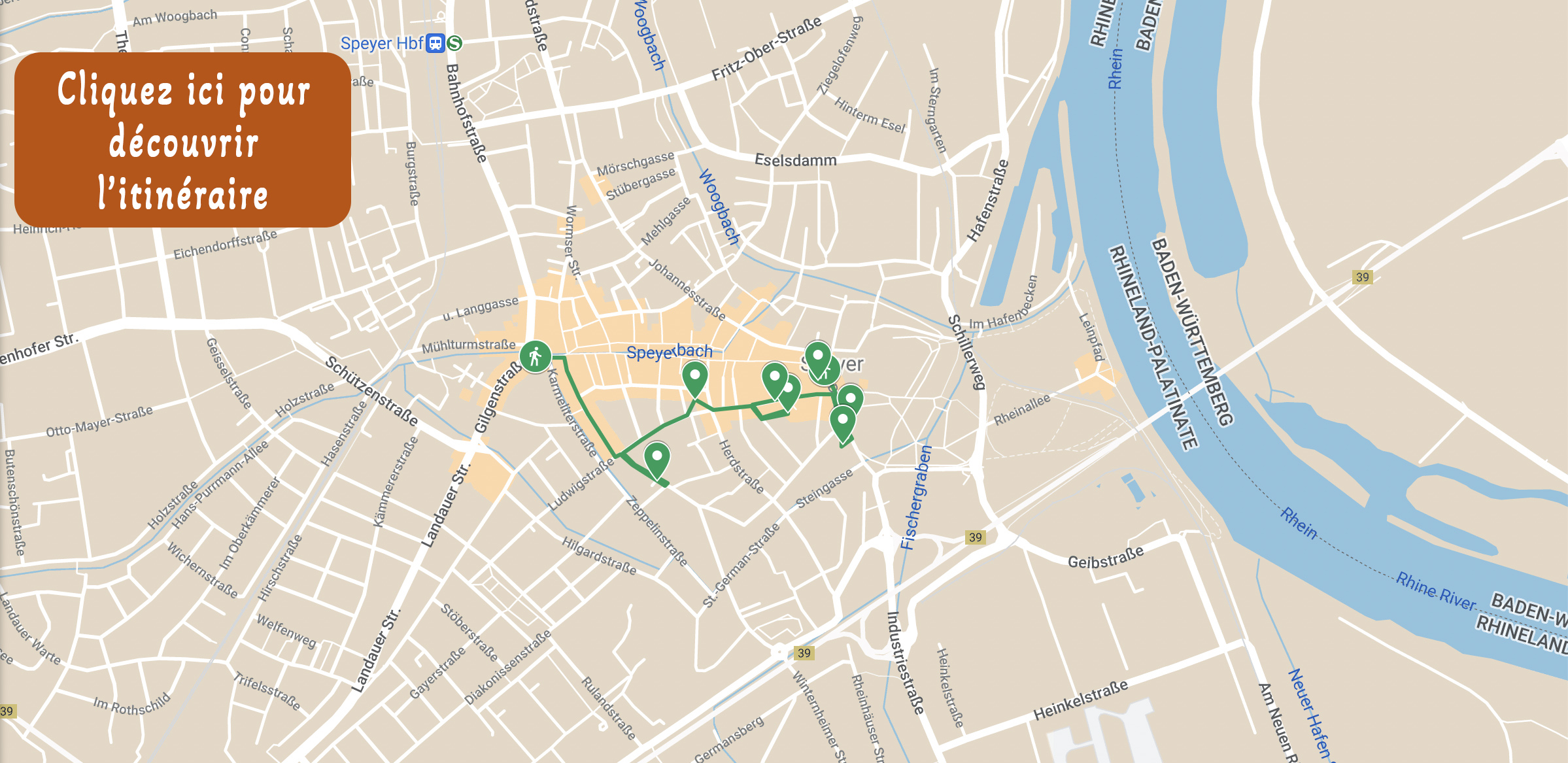
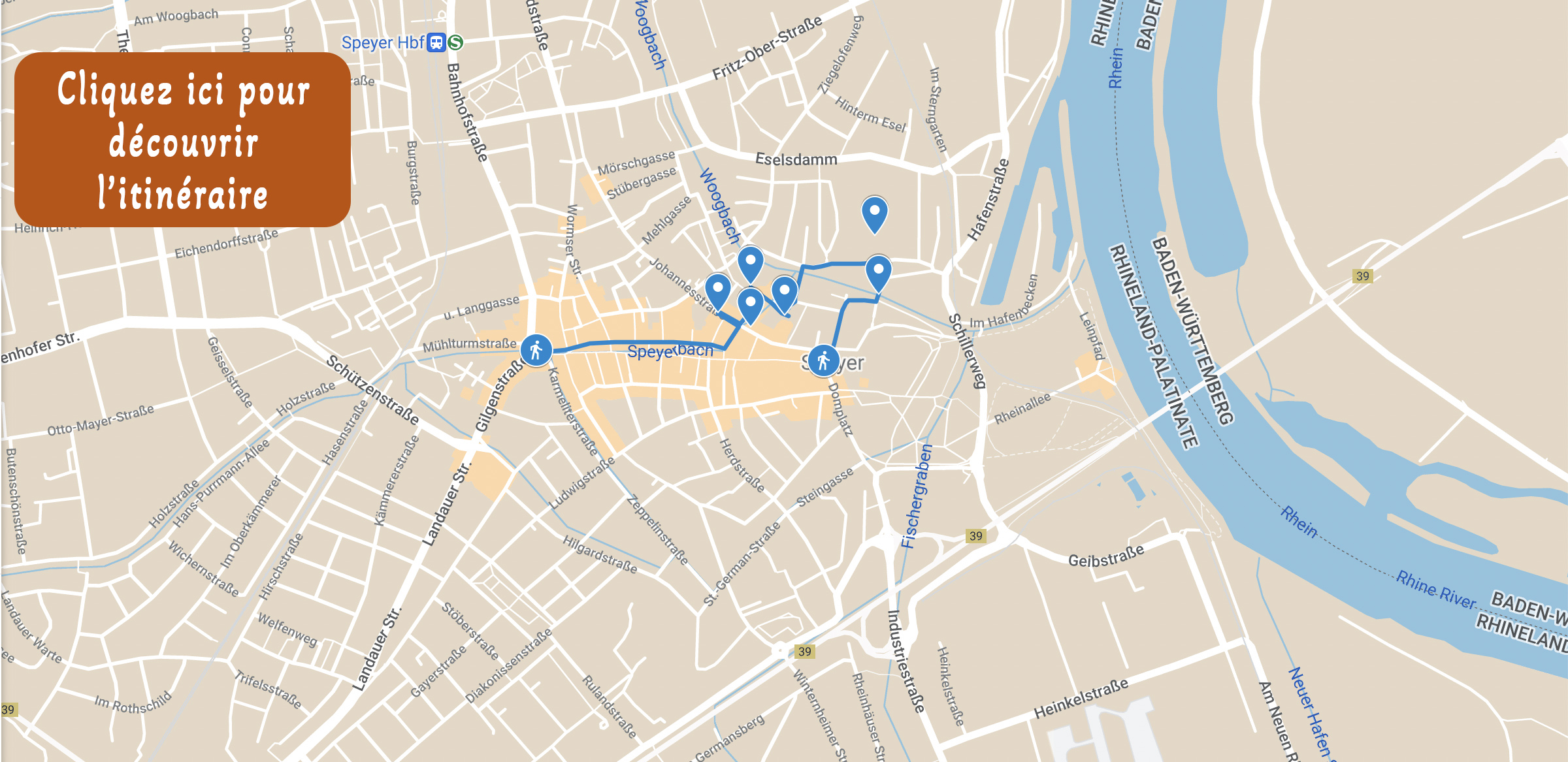
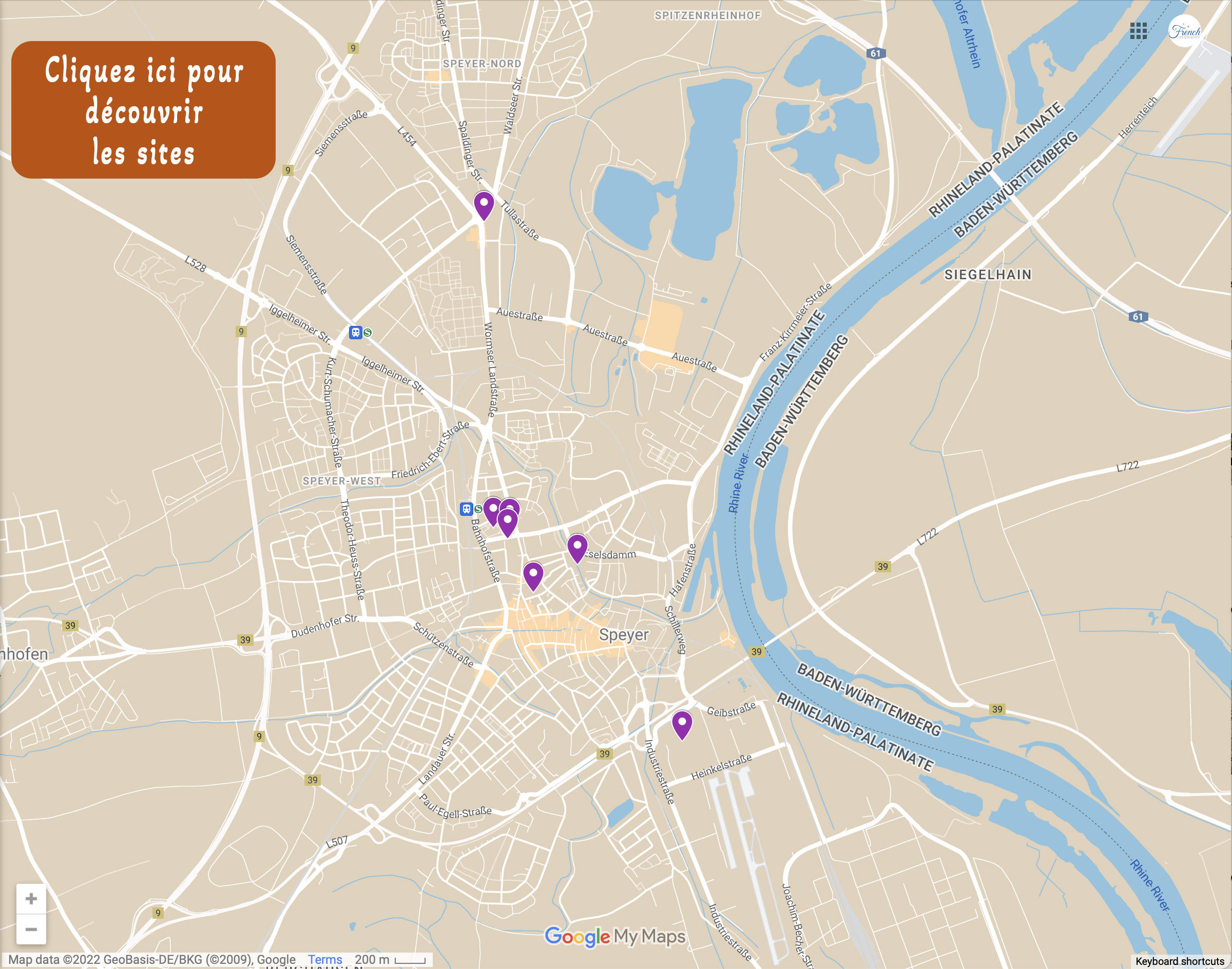
![Wilhelmsbau Technik Museum Speyer © Batke - licence [CC BY-SA 3.0] from Wikimedia Commons Speyer, Germany - Le Wilhelmsbau au musée technique de Spire, ancienne caserne française © Batke - licence [CC BY-SA 3.0] from Wikimedia Commons](https://frenchmoments.eu/wp-content/uploads/2025/01/Wilhelmsbau-Technik-Museum-Speyer-©-Batke-licence-CC-BY-SA-3.0-from-Wikimedia-Commons-scaled-1.jpg)

